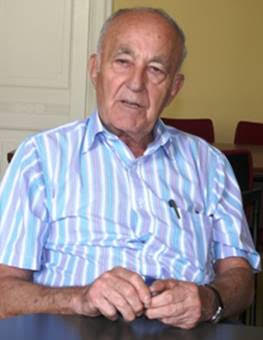
THE VOICE OF INTERNATIONAL LITHUANIA
|
VilNews has its own Google archive! Type a word in the above search box to find any article.
You can also follow us on Facebook. We have two different pages. Click to open and join.
|
Historical Lithuania
- Posted by - (2) Comment
 |
Commemorating January 1991
|

21 January 1991: Soviet military vehicles dominated the streets of Vilnius. Dag Andersen and I presented a letter from Oslo Municipality, signed by Mayor Michael Tetzschner. Oslo offered Vilnius to become its first friendship city in the West. The letter was enthusiastically received by the Vilnius Mayor Arunas Grumadas and Deputy Mayor
Regimantas Ciupaila. Photo: Aftenposten, Norway.
Aage Myhre, VilNews Editor-in-Chief
aage.myhre@VilNews.com
We were two Norwegians working very much with Lithuanian affairs during autumn/winter of 1990-91, Dag Andersen and me. During our visit to Vilnius in January 1991, we showed our respect to President Vytautas Landsbergis in his Parliament office and worked with journalists to spread the message about the Soviet assault to the world.
We also brought with us a letter from the City Council Leader of Oslo, Michael Tetzschner inviting the Mayor of Vilnius to sign a sister city agreement. We handed the letter over to Mayor Arunas Grumadas on 21 January while Soviet troops were standing around in the streets and armoured vehicles roared around us.
The twin city agreement was signed a few months later, and Oslo became thus the first Western city to enter into such an agreement with Vilnius. I saw it as an important symbol of friendship and solidarity at a difficult time for a country under tremendous pressure and terrible abuse from Lithuania’s power loving neighbour to the east.
|
OSLO
The Oslo coat of arms is almost 700 years old. It shows the patron saint, of Oslo, St. Hallvard, sitting on a throne decorated with two lions' heads with a halo around his head. In front of the throne lies the woman whom he tried to protect. In one hand he holds the three arrows which killed both him and the woman. |
VILNIUS
In pagan times, until the end of the 14th century, the Vilnius coat of arms featured Titan Alkis, hero of Lithuanian ancient tales, carrying his wife Janteryte on his shoulders across the river.
|
During 1991 I came back to Lithuania several times. I saw more, understood more. The country began in earnest to fascinate me. I was also in Vilnius during the failed coup in Moscow in August 1991, again thrilling days. On the morning of 30 August 1991 I was probably the first person in modern times who got a Lithuanian visa that was legally accepted internationally, stamped into my Norwegian passport. Early morning the 30th of August 1991, the day when the Lithuanian migration authorities finally could do so in accordance with international rules.
The Soviet Union was finally a horror of the past. Also formally, Lithuania was once again a free and independent country. 50 years of abuse and oppression was over!
Vilnius images, winter 1990-91
|
|
Heavy tanks were used by the Soviet forces when they attacked the TV tower and the Parliament building in Vilnius on 13 January 1991 (left). They were met by a wall of unarmed people who refused to allow the intruders to again take control of their homeland. Inside the city they used armoured vehicles on rubber wheels (below). It was a bizarre, almost surreal experience to always hear the noise, feel the ground tremble when we were in meetings or trying to get a meal in one of the city's few restaurants. |
|
|
|
We often did our eating and drinking in Hotel Lietuva, in the so-called 'Black Bar', where only western, hard currencies were accepted. This bar was the centre for international media those January days. Every night we heard stories about how television crews and journalists had experienced rather harsh confrontations with the Soviet military units. |
|
||

Windows all over Vilnius were taped like this those
January days, in order not to break when the heavy
Soviet vehicles passed by.
|
|
|
|
|
ABOVE: During my first visit to Lithuania, in November 1990, I took this picture at Rotušes Square (Town Hall Square) in Vilnius. This was probably the very last picture ever made of the statue of Vincas Mickevičius-Kapsukas here. Next morning he had been knocked down by local activists... After the WWII Soviet occupation of Lithuania, his student Antanas Sniečkus (see our article https://vilnews.com/?p=6598) propagated Mickevičius' personality cult. In his honour the city of Marijampolė was renamed Kapsukas (1956–1989) and Vilnius University (1955–1990) bore his name. Two large sculptures of Mickevičius were erected in Vilnius: one here, in front of the Vilnius Town Hall (1962) and another, depicting Mickevičius with Lenin, in Antakalnis (1979). LEFT: You can today find the statue of Mickevičius-Kapsukas in the Grutas Park in Southern Lithuania. The park is the repository of old Soviet era statues and artefacts that were removed from public places when Soviet occupation of Lithuania ended.
|

Delivery of coal to properties in Pilies g. right in the centre of Vilnius, with horses, 22 years ago.
People picked the coal up in burlap sacks. Other times the horse driver was simply shovelling
the coal out on the sidewalk in front of the buildings on his ordering list.
Photo: Aage Myhre.

One of the few shop windows in Vilnius in 1990-91.
Photo: Aage Myhre.
We came via Riga
We were a small group of Norwegians who travelled from Oslo to Vilnius a few days after the infamous Soviet attack and its killings on the 13th of January 1991. It was originally planned as a larger delegation, with parliamentarians, but they had to postpone their trip due to the death of our Norwegian King Olav.
We came to Vilnius via Copenhagen and Riga, whereto Scandinavian Airlines as the first western airline had established a route a few months earlier. Travel insurance cover was 400% higher than normal. The Baltic States were now defined as a war zone.
In Riga we first visited the Radio and Television House. The smoke from the many bonfires around the building lay like a blanket over the area, with a penetrating but good smell of firewood. It was an impressive sight to see the thousands of Latvians who camped around the territory in tents and primitive shelters to protect the freedom of peaceful broadcast against the Soviet perpetrators.
Inside Riga's Old Town there were equally many bonfires and barricades, especially around the Latvian parliament building. Our delegation was given entrance passes, and that night we stood inside the building to show our support and talking to MPs and others who stayed there, many of them around the clock.
In the evening we experienced a rather startling example of the Soviet propaganda machinery when there on the TV news from Moscow was informed that Soviet soldiers had just moved in and taken control of the Parliament and Riga city. Not a single soldier was to see, neither inside nor outside the building, but this was a stunning reminder of how disinformation and propaganda are important parts of any war or conflict.
It was dangerous to embark on the road those days, but the Latvian Customs agreed to drive us, in their red jeeps, to the Lithuanian border next morning. On the Lithuanian side of the border, which still was not established with checkpoints, we were picked up by Lithuanian Lada cars, and not long after we were on the way to Vilnius. We passed convoys of Soviet military vehicles, but arrived without being stopped or subjected to interrogation of any kind.
Our main mission of the trip began…

We, our Norwegian team, together with journalists travelled to Latvia and Lithuania as soon as we could after the Soviet attack in January 1991. The Balts refused to accept the Soviet invasion. They did their utmost to protect their governments and media. Here we are with 'activists' in Riga. For several weeks they made bonfires, staying here in tents night after night to demonstrate against the new Soviet assault.
Photo: Aage Myhre, January 1991.

Without the intense media coverage that took place in January 1991, the outcome could well have become different. The Soviet occupiers could have re-taken control of the Baltic States. Here a journalist from Norwegian Aftenposten interviewing the leader of the Latvian border guards. The international press made a huge effort to make the world know about the Soviet atrocities.
Photo: Aage Myhre, January 1991.
Lithuania – Norway, a strong alliance also today!

- Bookmark :
- Digg
- del.icio.us
- Stumbleupon
- Redit it
- Posted by - (1) Comment

Visit to the Lithuanian
Parliament (Seimas)
22 years later
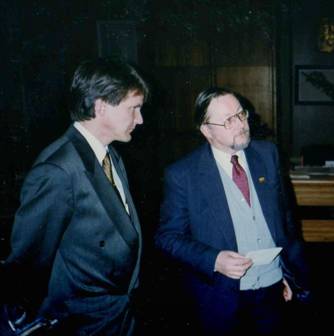
Lithuanian Foreign Ministry issued primitive passes for us,
and we managed to get through a long maze of controls,
barbed wire, concrete blocks and barricades that surrounded
the Lithuanian Parliament those January days in 1991. We got
the opportunity to visit this brave Parliament President,
Professor Vytautas Landsbergis, in his office. Here he
lived day and night for weeks while the Soviets
surrounded the building with troops and tanks.
Text and photos: Aage Myhre, Editor-in-Chief
aage.myhre@VilNews.com
This year I marked 13 January in the Lithuanian Parliament Building, 22 years after I in 1991 stood here in this building, along with Professor Landsbergis and looked out the window at the bonfires, barricades and the huge crowd of unarmed people who had gathered to protect their president and the country's future as a free nation.
I came here today with a group of young Lithuanians, most of them so young that they do not have their own memories of what happened here 22 years ago. Yet the memories of the sad events in January 1991 are very much alive and present for them. They want to remember that freedom and independence is not something you can take for granted, and they want to pursue a political career. They are Lithuania's future politicians. They are the future of young, well-educated, smart leaders that this country a few years ago could only dream about.
I walked around with them in the Parliament this 13th January. I saw their interests, and their pride in belonging to a great nation like this.
I also saw large photographs on the walls, with Lithuania's parliamentary history of the interwar time and from the years after the Declaration of Independence 11 March 1990. The sadness I felt when I walked around in these corridors 22 years was gone, now I felt only joy, and optimism regarding the country's future and its political leaders for the years to soon come.

Entrance to the old part of the Parliament.
HISTORY OF TODAY’S PARLIAMENT BUILDING (SEIMAS)
The construction of the new Seimas building began in April 1976, on the site of a former stadium. By then, the Parliament was still directly depended on the Communist Party. The legal acts passed by the Supreme Council of the USSR was just a “decoration” of the Soviet order. Selected by sex, nationality, education, professions, membership in Communist or Young Communist organisations, the local trade union, so-called deputies used to convene two or three times per year and voted on the draft legal acts already submitted. Undoubtedly, this was an imitation of government, a spectacle. Indeed, the main lobby could remind one of a theatre.
Today’s democratic parliamentarian system got its first test on 11 March 1990, when the Lithuanian Supreme Soviet elected Vytautas Landsbergis president and formally declared Lithuania to be an independent nation. The Soviet President M. Gorbachev rejected the action, insisting that a separation had to be negotiated. In April same year he ordered an economic blockade of Lithuania, cutting off all oil supplies and reducing natural gas flow to one-quarter of the normal level. The blockade ended on 30 June after the Lithuanian Parliament voted to freeze the declaration of independence for 100 days in order to permit negotiations between Moscow and Estonia, Latvia, and Lithuania.
Then came 13 January 1991. That was the day when Soviet troops cracked down in Vilnius and the resulting bloodshed made headlines around the world. The action was apparently a bid to stop Lithuania’s independence drive in its tracks. But President Landsbergis and other political leaders wanted it all very differently, making the Parliament building a fortress for democracy and freedom those winter days, with thousands and thousands of unarmed Lithuanians surrounding the building and thereby stopping the Soviet troops from attacking.

ABOVE: The Lithuanian Parliament building as it looks today.
BELOW: Pictures on the Parliament walls, describing Lithuania’s parliamentarian events in 1990-1991.



ABOVE: Seimas, 11 March 1990, the day Lithuania re-claimed its independence.
BELOW: The same Parliament Hall today.


Today’s top modern Parliament Hall.
|
|
On the 11th of March 1990 the Lithuanian Supreme Council (today’s Parliament) decided to change the Soviet Coat of Arms hanging behind the chair of the parliament president (above), to Vytis, the symbol of genuine Lithuania (left). The coat of arms of Lithuania, consists of an armour-clad knight on horseback holding an olden sword and shield, also known as Vytis ("the Chaser"). The Lithuanian coat of arms is one of the oldest national coats of arms in Europe. It is one of very few containing symbolism adopted from ducal portrait seals rather than from coats of arms of dynasties, which is the case for most European countries.
|

ABOVE: Barricades and bonfires outside the Parliament in January 1991.
BELOW: This is what is left of the barricades today, covered by a modern glass structure.

BELOW: The Parliament’s entrance hall on 13 January 2013, filled with activities in memory of 13 January 1991.




80 year old Liuda Komarovskaja lost her health by defending the Vilnius TV Tower in the 13 January 1991 events.
She was beaten unconscious by the Soviet soldiers and rushed to the Santariškių Hospital in the outskirts of Vilnius. Here in conversation with Parliamentarian Petras Austrevicius in the Parliament last Sunday.

ABOVE: Antanas Terleckas, founder and leader of the Lithuanian Freedom League, was awarded the 2012 Freedom Prize at a solemn event at the Lithuanian Parliament on Sunday 13 January. Read more at http://www.15min.lt/en/article/culture-society/freedom-prize-awarded-to-lithuanian-freedom-league-leader-antanas-terleckas-528-296400
BELOW: A special exhibition about Antanas Terleckas’ life was presented in the Parliament during the13 January commemoration days.

BELOW: Pictures on the Parliament walls, from interwar sessions.


- Bookmark :
- Digg
- del.icio.us
- Stumbleupon
- Redit it
- Posted by - (0) Comment
 The bonfires and
The bonfires and barricades that
saved Lithuania


In
January 1991, the Lithuanian Parliament was for weeks surrounded by hordes of people,
bonfires, concrete blocks and vehicles that the Lithuanian people had brought
there to protect their leader and their elected representatives against the
Soviet atrocities against innocent people. Today, exactly 22 years later,
the
Parliament is surrounded by peaceful, quiet winter streets.
Top
photo: Zenono Nekrošiaus
Text
and photos: Aage Myhre, Editor-in-Chief
aage.myhre@VilNews.com
It was not bonfires, concrete blocks, steel beams, barbed wire or tractors which in themselves rescued Lithuania in January 1991. But it was these simple remedies, not weapons, that came to represent the peaceful resistance Lithuanians showed towards their powerful opponent from the east.
I'll never forget the sight of the flames and the large crowd that met me the day I was walking down the Gedimino prospekto towards the Parliament an icy winter day in January 1991. I read a combination of hope and despair in the faces, but first of all I saw determination. This time we will not surrender! The Soviet Union shall not again be allowed to trample us down under its iron heel!
The tactics succeeded. The Lithuanian people united as never before, or since, and the assailants had to withdraw in favour of a free and democratic Lithuania. Some of the symbols of this defining moment in our country's history can still be seen outside the Parliament.


In
January 1991 I crossed the barricades to visit President Vytautas Landsbergis
in
his Lithuanian Parliament office, while the Soviet troops and tanks continued
to
surround the building. 14 years later we visited together what was left of the
concrete
barricades from that time. These are now protected by a glass structure.

1991


2013



1991




2013

It
was very touching to see how the Balts acted to keep their newfound freedom and
protect their home country during the very difficult January days of 1991. Here, at the entrance to the Lithuanian Foreign Ministry,
the young men have put on homemade clothes that are meant to look like
uniforms. They carry rifles and other
weapons they have found in their homes. Sand
bags have an important symbolic effect. Brave guys!
Photo:
Aage Myhre, 18 January 1991.
- Bookmark :
- Digg
- del.icio.us
- Stumbleupon
- Redit it
- Posted by - (0) Comment
How a Lithuanian from America
ended up in the middle of historic
Jan. 13 events in Vilnius

By: Linas Johansonas LTnews.net
(Cleveland) Linas Muliolis was your average young Lithuanian born in the USA. The son of World War II refugees, Linas grew up in Cleveland's Lithuanian community. In January 1991, he was just a month away from turning 21 years old & was in Vilnius during the historic Jan. 13 events. Earlier this week, LTnews.net talked with Linas about his experiences 22 years ago.
HOW DID A YOUNG MAN FROM CLEVELAND END UP IN VILNIUS DURING A 'REVOLUTION'? "I went there (Lithuania) to live for a year, to study language at Vilnius University. Things were heating up and in the beginning of January, I went there (parliament building) and volunteered to be an interpreter. I worked in the information bureau with Rita Dapkute".
WERE YOU AT THE PARLIAMENT BUILDING ON JAN. 13? "Yes. I was there for four days with only two, four-hour breaks of sleep ..... Had my own gasmask issued to me". (it was 108 hours with 2 four-hour naps)
WERE THERE ANY OTHER "VOLUNTEERS" FROM ABROAD THERE? "From America, I think Rita Dapkute, Darius Suziedelis & I were the only 3. There was a group from Moldova. There was about a half dozen of them, in case of attack, they were there mostly for moral support but it was nice to have them there... very well received".
SO THE MOLDOVANS WERE THERE TO DEFEND THE PARLIAMENT BUILDING? "Basically yes... I can't remember if they were armed... I think I only remember seeing guns once ..... on the main floor..."
DID YOU EVER WORRY ABOUT WHAT WOULD HAPPEN TO YOU IF THE SOVIETS TRIED TO OR DID TAKE OVER THE PARLIAMENT BUILDING? "No, not at all, why would I worry about that? (he answered jokingly). I made sure I kept my passport with me at all times, in case.. who knows if it would have helped, though. I always said the rest of my life would be anti-climactic".
WERE YOU EVER TOLD WHAT TO DO IF THE BUILDING WAS ATTACKED? WERE YOU GIVEN A GUN? "No - there were practically no guns to be seen, this was primarily a peaceful protest... I WAS issued a gasmask though, because there were rumours of attack by gas".
WAS THERE EVER A TIME YOU THOUGHT TO YOURSELF 'WHAT AM I DOING HERE? AM I GOING TO DIE'? Yes, the whole time!
WHAT WAS THE MOOD LIKE INSIDE THE PARLIAMENT BUILDING ON JAN. 13? "STRESS! Pretty much what you would expect, desperation, frustration with the rest of the world, stress, worry, fear... etc".
WHAT WAS THE FRUSTATION WITH THE REST OF THE WORLD?
About non action. I remember one newspaper cartoon, for example, a rear view of Landsbergis facing a window, you see from the back that he is holding a phone, the view out the window shows a new oil well spraying oil in the air.. He says "President Bush? Guess what!"
The world was focused on the first Iraqi war, but yet on Jan 13th, we still made the top headline
DID YOU EVER CROSS PATHS WITH VYTAUTAS LANDSBERGIS DURING THIS TIME? "Yes. I was in his office once or twice, I was called in to help translate one night.. but I didn't do a great job, though, I have to admit. Once you get technical in some subject, you know how hard it can get".
WHAT WAS LANDSBERGIS LIKE? "He was calm, focused, definitely calm and reserved".
WHEN DID THOSE OF YOU IN THE PARLIAMENT BUILDING HEAR ABOUT THE CIVILIAN DEATHS? We heard about the deaths as they were happening. I remember the death count rising. I was surprised how accurate the news reports were in the US and in the UK, everything was pretty accurate, sometimes the number of deaths was off, but considering how confusing the time was overall, the news articles I saw were close to reality.
DID YOU HAVE ANY CONTACT WITH YOUR FAMILY BACK IN CLEVELAND? Yes. After I took the photo of the Soviet tanks (posted below) I was on the phone with my mother at the time, "Mom, don't be scared, but there is a column of tanks going by" probably was not a good thing to say to my mom. She turned gray that year.
BEING AN AMERICAN-BORN LITHUANIAN, HOW WERE YOU TREATED BY THE NATIVE LITHUANIANS IN THE PARLIAMENT BUILDING? "People were grateful for me being there. I was generally well accepted By that time I had learned to look and act local, gotten rid of most of my American accent, though"
WAS THERE ANY SINGLE MOMENT THAT STANDS OUT FOR YOU? "The single most amazing thing I saw happened late at night, I believe it was on the night of January 12th, I may be wrong. Do you remember the photo of the lone Chinese man standing in front of a column of tanks at Tiananmen Square? The Parliament Building is right next to the river, and there was a bridge over it leading to the square where hundreds of thousands of people were protesting and guarding our fledgling government. That night, suddenly someone in the room called out, said there were reports of a column of tanks racing towards us.. Hearts pounding, we raced to the windows. I was on the fourth floor so had a great view. A long column of tanks came racing towards us. The most amazing thing I have ever seen in my entire life, was the mass of people simply rush in to block the way. Those tanks would EASILY have crushed hundreds of people in seconds if the continued through. I have never witnessed such bravery and selflessness in my entire life. Luckily, however, at the last seconds, those tanks and APC's slowed down and turned right, away from the Parliament Building ".
WHEN DID YOU FEEL EVERYTHING WAS GOING TO BE OK? "When most of the tanks left".
ANY FINAL THOUGHTS? "This was definitely one of the most memorable times of my life, something I will never forget! My whole life I had been taught that someday Lithuania will again be free, that we needed to keep the language and culture alive.. Then, when I was 20, turning 21 - It happened and I was a part of it!"

Cleveland Plain Dealer - Jan. 1991

Photo by Linas Muliolis taken from parliament building - Jan. 1991

Photo by Linas Muliolis taken from parliament buikding - Jan. 1991

Linas Muliolis - Cleveland, Ohio - 2012

Jenifer C. Dillis Simply heart-stopping...

Linas K Muliolis I have to add something to this, I don't know how I forgot.. You caught me during an extremely busy week for this interview and I did not get enough chance to rehash all of the events. The single most amazing thing I saw happened late at night, I bel...See More

Jean-Paul Le Clercq Go Linas Go! The Soviets had no idea what was waiting for them behind Parliament walls!

Sam Salerno I feel shameful that I've never heard of this. Makes me wonder what else is going on in the world today that I don't know about. You're an Awesome man Linus.

Jūra Liaukonytė Thank you LT news for this interesting interview.

Dana Baltutis Yeah...its an event I wont forget. I still have the videos that my close friend Monika, her mum and I smuggled out via the Australian embassy in Moscow a few weeks later.

Rita Kova Murnane I was there in August of 91...

Jurate Grigonis Dana Baltutis from Australia was also there.

Tony Geraci Wow!

Ruta Rusinas Tomas Zizys from Toronto was also there.

Mardell Ward awesome! that was really interesting.

Dana Baltutis We were standing outside the television station when the tanks came and the soldiers started to jump out of the tanks with their guns.. Ill never forget the rumble and confusion. A friend who I was with got shot in the leg. We had to crouch down and run from the gunfire. People were so brave that night and next morning going to the Parliament knowing what had happened the night before.

Mindaugas Petrauskas Another unsung hero.. The majority of Lithuanian people do not know anything about stories like this.

Giedrius Pavardenis Hey guys, you're all awesome

Roberta Zarnauskaite We can only admire the unity and bravery of people at that time!
I wish nation still has it in the blood!!
Peace to all!
- Bookmark :
- Digg
- del.icio.us
- Stumbleupon
- Redit it
- Posted by - (6) Comment
If there were those in the West who had not heard of Lithuania before, they almost certainly had by the end of the day 13 January 1991
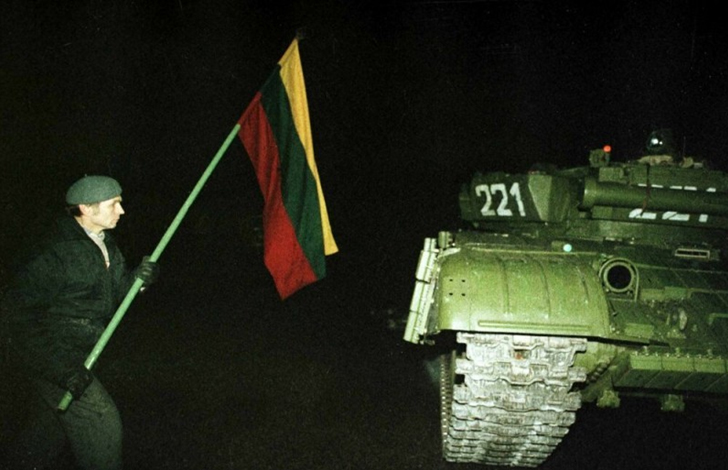
Heavy tanks were used by the Soviet forces when they attacked the Vilnius TV tower and the Parliament building on 13 January 1991. They were met by a wall of unarmed people who refused to allow the intruders to again take control of their homeland.
Text: Aage Myhre, editor-in-chief
aage.myhre@VilNews.com
"Lithuanians, do not resist, your government has betrayed you. Go home to your families and children."
This was the repeated announcement from the Soviet military vehicles with loudspeakers on the roofs, so-called sound trucks that rolled through the streets of Vilnius in January 1991. But fortunately for Lithuania and the United Europe that we now take more or less for granted, there was a music professor and a complete small nation that wanted it all differently.
Had it not been for this peaceful struggle of recovered freedom against an invasion and occupation, the people of the Baltic States never wanted or agreed to, the map of Europe would most likely have looked quite different today.
If there were those in the West who had not heard of Lithuania before, they almost certainly had by the end of the day 13 January 1991. It was the day that Soviet troops struck in Vilnius. The bloodshed that followed made headlines around the world. The attack was apparently an attempt to stop the Lithuanian independence movement in its very beginning.
When the smoke of the Soviet weapons ceased, more than a dozen people had been killed, hundreds injured. Soviet’s attack, and especially the killings at the TV tower, brought not only fame and sympathy for Lithuania from around the world, it was also a defining moment for the Lithuanians themselves.
The bloodshed meant that a point of no return had been crossed. If there was someone who until now had believed that a peaceful settlement with Moscow was possible, it was now clear to everyone that such a thing was unthinkable.
The 1991 January events took place in Lithuania between January 11 and 13, in the aftermath of the Act of the re-establishment of the State of Lithuania. As a result of Soviet military actions, 14 civilians were killed and more than 1000 injured. The events were centered in Vilnius, along with related actions in the cities of Alytus, Šiauliai, Varėna, and Kaunas.
Professor Vytautas Landsbergis was the central actor in the drama that took place . The colourful, sometimes tempered music professor who was elected Lithuania's president (chairman of the parliament) in March 1990, and from then on become the symbol of the Lithuanian liberation movement. Before the attack in January 1991, his constant talks about breaking free from the Soviet Union, and Lithuania's moral right to do just that, alarmed observers in the West almost as much as in the Kremlin. When the rage was taken completely out of hand in January 1991, Gorbachev seemed as if he did not understand what was happening right in front of him.
Our little Norwegian delegation met with Landsbergis in the parliament on the 19th of January 1991. He lived there, entrenched, protected by his own people. Tens of thousands were ‘camping’ outside the building, inside homemade barricades of concrete blocks and barbed wire. Trucks and tractors were also part of the barricades. In a circle further out stood the Soviet forces, ready to attack when the command word would be given. Fortunately it didn’t happen. The pressure had become strong from all around the world.
We got through the barricades. The Ministry of Foreign Affairs had provided us with appropriate admission papers. It was a moving encounter with a brave man we experienced inside. The little stroke that fell the huge oak. World history was created there and then. In front of our eyes. We were the eye witnesses.

The editor with President Vytautas Landsbergis in the Lithuanian Parliament (Seimas), while the
Soviet troops and tanks continued to surround the building in January 1991.

Bonfires, day and night, outside the Parliament, January 1991.
Photo: Aage Myhre.

Bonfires outside the Parliament, January 1991.
Photo: Aage Myhre.

A human barricade surrounding the Parliament, January 1991.
Photo: Aage Myhre.

With Landsbergis inside the Parliament, 19 January 1991, and his handwritten greeting to the editor.

Homemade barricades of concrete blocks around the Parliament.
Photo: Aage Myhre.

It was very touching to see how the Balts acted to keep their newfound freedom and protect their home country during the very difficult January days of 1991. Here, at the entrance to the Lithuanian Foreign Ministry, the young men have put on homemade clothes that are meant to look like uniforms. They carry rifles and other weapons they have found in their homes. Sand bags have an important symbolic effect. Brave guys!
Photo: Aage Myhre, 18 January 1991.

Inside the city armoured vehicles on rubber wheels were used. It was a bizarre, almost surreal experience to always be spotting, hearing the noise, feel the ground tremble when we were in meetings or trying to get a meal in one of the city's few restaurants.
- Bookmark :
- Digg
- del.icio.us
- Stumbleupon
- Redit it
- Posted by - (0) Comment
13 January 1991
through an artist’s eyes
 The photo. |
Artist Ruta Brazis-Velasco: This painting was done as an exercise in college of a trauma painting, done in oil with a pallet knife in 5 minutes. I used a Magazine type book that documented the truth.” |

- Bookmark :
- Digg
- del.icio.us
- Stumbleupon
- Redit it
- Posted by - (0) Comment

2nd World War was over
- though not in Lithuania
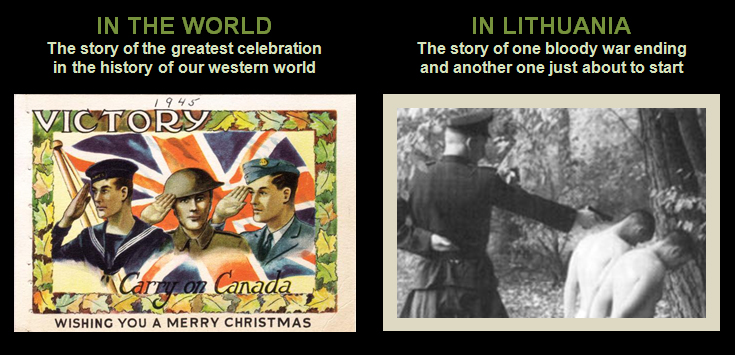
Christmas of 1945 was over most of the world celebrated with a joy and delight almost never before seen. Young and old gathered in homes, on streets and in churches. An endless series of victory ceremonies took place in almost every corner of the world. With a deep sense of joy and gratitude all wanted each other warm, comfortable and relaxing Christmas holidays, knowing that the Nazi era was over and that the world now more than ever could look forward to a future of peace and prosperity. The war had finally released the grip, forgotten was the economic recession of the 1930s. Forgotten was also our Western World’s close friends and neighbours - the Baltic States.
On a small farm in northern Lithuania, in the outskirts of the village Šilagalis, Christmas 1945 is nearing. It is the 22nd of December, and the mother of the house feels very happy that her 21 year old son Povilas has finally come home to visit after having been away for many months.
He has come to change into dry clothes to keep him warm through the cold winter days waiting. His mother is infinitely happy to have her son home this one day, and she does everything she can to treat him with all the good food and drink their little farm can produce. You never know how long it will be till next time.
Povilas had joined a local partisan group earlier in 1945, and now spends all time in the North Lithuanian forests where the local "forest brothers" have established their hideouts. It is from these caches, usually at night, that they conduct their operations against military installations and forces of the Soviet Red Army and NKVD (the secret Soviet police that later changed name to KGB).
The Soviet occupation of Lithuania has lasted for more than a year now, but Povilas and other forest brothers still hope that their constant needle sticks can get Josef Stalin to pull his troops out of Lithuania and the other two Baltic countries.
Povilas is pleased to finally have got a day off, not least is he happy to eat real Christmas food and enjoy some Christmas cheer with the family. A small fly in the ointment is the fact that his father, little sister and little brother are not home.
Both the brother and the sister go to a boarding school in the nearest town, Panevežys, and his father had early in the morning that same day left for the town to bring them home for Christmas. But his mother is here, and when she and he, with arms around each other, go out in the barn to feed the animals, he sings with joy a song he so often has sung in the partisan camp in recent months:
"Dying young is difficult, but not for my country. For my country, Lithuania, I am ready to sacrifice my young life. "
His mother scolds him motherly strictly that he sings: "You know it is not proper to sing now that it's Advent," she says. Lithuania's Roman Catholic Church is strict when it comes to how to behave through the various festive times of the year, and his mother admonishes her son, therefore, while at the same time feeling proud and happy that he makes such an honourable service to the home country.
Back in the farmhouse they suddenly hear that the dog starts to bark. Through the window they see a group of soldiers approaching. The soldiers are still on some distance, so Povilas has time to hide in a small cellar room they have made beneath the living room floor, and the mother has time to cover the cellar hatch as best she can.
The cellar room has also previously been used to hide partisans, and both think this is a safe hiding place until the soldiers have left again.
The mother walks out into the yard to meet the soldiers from the Soviet Red Army. They ask if her son is home, and if he, in case, is alone. Without waiting for an answer, they storm into the house and begin to turn upside down on furniture and fixtures. Then they start shooting down to the floor to see if it can be cavities under the floorboards. It takes some time before they discover the cellar hatch, but as soon as they find and open it, they fire a machinegun volley into the hole. It does not take long before they pull the now perforated and lifeless body of Povilas out of the basement. The whole operation has taken them five hours, but they have found what they sought. One more young Lithuanian life has been lost in the desperate struggle against the overwhelming odds.
The distance from the farm to the road is over 500 meters, so the soldiers find a chain in the barn so they can tow the corpse of Povilas across the fields over to the military vehicle waiting. The mother is forced to follow, and soon they are on their way to the NKVD headquarters in Panevezys, where the body of Povilas is thrown out in the middle of the courtyard. His mother is brought to a prison cell in the basement.
Early next morning, Christmas Eve 1945, the mother is brutally dragged up from the wooden bench she has laid sleepless on during the night. Today, and every subsequent day for two weeks, she is brought up to ever-new interrogations, walking across the courtyard where the mutilated body of her son still is lying.
Christmas and New Year holiday season in 1945 passes with this terrible routine for a mother in tears and sorrow. Early in January, she is released and can finally go home and tell the family what has happened.
In thousands of homes around the world happy families walk around their Christmas trees. They celebrate that Jesus is born and the world's evil is overcome. 1946 is the beginning of the new and bright times for the human kind…
In northern Lithuania the parents of Povilas and other parents finally find out where the bodies of their killed young partisan sons have been dumped. Under the cover of dark nights in early January 1946, they manage to bring the bodies of their children home to secret burials in their hometown cemeteries.
Christmas 1945 is over. Most of the world looks forward to many good years of peace, freedom and economic growth. The Baltic States' ten-year guerrilla war against the occupiers has just begun.
* * *![]()
The story of Povilas is real. It is based on a passage from the book "Lithuania's struggle for freedom" (Lithuanian Partisans' War Chronicles).
Povilas Peleckas was born on 24 January 1924 into a farming family in the village of Šilagalis in the Panevežys district north in Lithuania. He attended Šilagalis primary school. Later he helped his parents on the farm. In 1944 when the USSR invaded and occupied Lithuania for the second time (first time was in 1940), Povilas was due for conscription into the Red Army. He refused to go. When a local partisan unit was formed, led by Major Januškevičius, Povilas joined the fighters. In September 1945 many of the members of the unit were killed in battle, and another three were killed at the beginning of December. Those who remained alive determined to join a larger partisan unit. But fate was against them.
|
“Across America, people crowd churches praying with gratitude for the peace in place, and reach out to wounded veterans, children who lost fathers, and neighbors who lost sons. Americans in big cities and small, participate in displays of the intrinsic love so indicative of the American spirit.” |
In 1944-45 Lithuanians were forced to realize that the bloody World War II had been replaced by a new war, the longest and bloodiest guerrilla war in modern European history, lasting from 1944 to at least 1953. |
- Bookmark :
- Digg
- del.icio.us
- Stumbleupon
- Redit it
The West ignored all Soviet abuses!
- Posted by - (4) Comment

Joseph Stalin (1878 – 1953) One of the most powerful and murderous dictators in history, Stalin was the supreme ruler of the Soviet Union for a quarter of a century. His regime of terror caused the death and suffering of tens of millions, but he also oversaw the war machine that played a key role in the defeat of Nazism.
Illustration: http://sspurlock.wordpress.com
By Tony Olsson, North Devon, UK (guest blogger)
How could the western nations ignore the abuse by its wartime ally the USSR of all of the countries it had conquered during WW2?
Why didn’t America and Britain declare war on the USSR as its tanks and troops invaded Hungary, Czechoslovakia, and Poland?
Why was the attempt by Gorbachev to bring the Baltic States countries to heel by armed force ignored by the British press?
Why do western arms manufacturers sell guns and tanks and war planes to corrupt regimes that they know cannot act responsibly?
Why did the western nations not only not take punitive action against China for the Tiananmen Square massacre and on-going human rights abuses, but have put their countries in hock to China by closing down and moving the bulk of their manufacturing capacity to that country?
Why did NATO take so long to decide to act against Libya, and why hasn’t it acted against the rulers of Syria, Yemen, Zimbabwe and ... ? I could go on and on; the list is endless.
And why hasn’t action been taken against the rulers of Israel and Russia for the atrocities they are inflicting against other nations in the support of their own vested interests?
If Russia did invade in order to bring “its” Baltic republics back into the fold, would NATO come to their aid?
I was born the day President Roosevelt of America died a couple of weeks before the end of WW2, so have lived through, but mercifully have not been involved in any of the above conflicts. I can remember as an eleven year old, being very angry that Britain and America did not go to the aid of Hungary in 1956. The invasion of Czechoslovakia produced the same reaction, but was tempered by the bizarre coincidence that on the day the USSR invaded, I was at a concert in Norwich, England, given by the USSR State Symphony Orchestra conducted by Maxim Shostakovich. I think his father’s 5th Symphony was one of the works performed.
Sadly the answers to the questions boil down to VESTED INTERESTS.
A fear of WW3 is always at the back of the mind, but none of the major conflicts since 1945 has gone that far. It can’t be ruled out though..
So ultimately it comes down to smaller scale vested interests, all of which revolve around money: the arms manufacturers who don’t care who gets killed as long as they make a profit; the financiers who make money by investing money with firms who do business with corrupt regimes; the manufacturing bosses who put thousands out of work because they will make bigger profits if they move production to other countries (and I’m not talking just about China here); the politicians who will not act against a corrupt regime because that could result in reprisals against the organisations doing business with the corrupt regime; the group of countries that will not support a member that wants to act out of line, or even an enlightened politician who has ideas out of line with the prevailing majority (as a former USSR republic you know only too well what I am referring to).
Sorry to be a pessimist, but I see no end to the suffering. But to Aage Myhre and everyone who has suffered and is suffering pain because of past and present injustices, all I can say is the problems were too big to be dealt with at the time, and many are too big to be dealt with now. But be reassured by the fact that the tyranny of Stalin and his neo-Nazi version of Communism came to an end eventually. Patience rather than mental agonising and reprisals can win, even though it will be painful at the time. Wisdom to judge when a course of action can achieve the desired result is useful, as is the bravery needed to take a stand against injustice.
Tony Olsson
10 Oxford Grove, Ilfracombe, North Devon, EX34 9HQ, UK
- Bookmark :
- Digg
- del.icio.us
- Stumbleupon
- Redit it
- Posted by - (11) Comment
The longest and bloodiest
partisan war in modern Europe
LITHUANIA, LATVIA & ESTONIA 1944 – 1953
Text: Aage Myhre, VilNews Editor-in-Chief
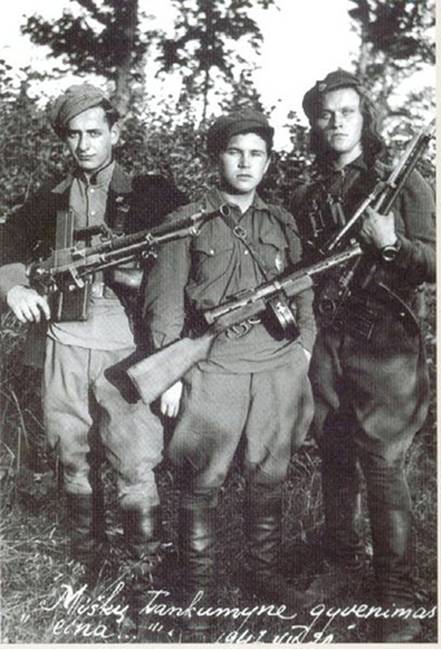
Lithuanian 'forest brothers' from the so-called "Vytis" military district.
Pictures: Mostly from the KGB Museum in Vilnius
Tell a Lithuanian that his country was liberated and that peace after WWII was restored on the 9th of May 1945, as the Russians claim. Tell him that this May 2011 it is 66 years since the Soviet Union and the Western world defeated Hitler's Nazi regime, and that Lithuania since then has been a free, happy country in line with what other European countries experienced after they were occupied in 1939 – 1940 and liberated in 1945. Do not be surprised if you get an angry and annoyed look back. For while we in the Western world, in Russia and in other parts of the world joyfully could celebrate the liberation and the recovered freedom after the World War, Lithuania, the other two Baltic states, and Ukraine were forced to realize that one war had been replaced by a new, much bloodier and more protracted war, lasting from 1944 to at least 1953. What we in the west celebrated in May 1945 was by Lithuanians and the other occupied countries experienced only in 1990 –1991.

The end of World War II saw a Germany dramatically reduced in size. Before long it was also divided into East and West. Germany's defeat meant that Poland and Czechoslovakia returned to the map of Europe after a six-year absence. But not so for Estonia, Latvia, Lithuania, Ukraine and northern East Prussia (Kaliningrad) that all remained occupied by the USSR.
Western radio stations told us, who were lucky enough to grow up on the western side of the iron curtain, thoroughly about the Hungarian uprising against the Soviet intervention in 1956, an uprising that resulted in 2,500 Hungarians and 700 Soviet soldiers losing their lives.
Western television stations showed us in detail what happened when Czechoslovakia was invaded in 1968 by more than 200,000 troops from the Warsaw Pact countries Soviet Union, Poland, East Germany, Hungary and Bulgaria - with the outcome that 72 Czechs and Slovaks were killed when they tried to resist.
However, we got almost nothing to know about the many, many times bloodier uprising against the Soviet that was happening right outside our own front door, in the Baltic States, through nine long years from 1944 to 1953.
It is estimated that approximately 30,000 Balts and 100,000 Soviet soldiers died in this bloody guerrilla war when Estonians, Latvians and Lithuanians withdrew into the woods to organize its powerful armed partisan resistance after the Soviet Union at the end of the second World War, in 1944, pushed the German forces out, and Stalin decided to incorporate the Baltic States into his powerful autocracy instead of giving these countries their freedom and independence back. Today we know that this tragic, involuntary occupation and oppression was to last the whole 47 years, from 1944 to 1991.

Entering a Siberian Gulag (leaf from Eufrosinia Kersnovskaya's notebook). During the period 1940 – 1953 Stalin’s Soviet deported approximately 600,000 individuals from the Baltic States to Siberia. Around 100,000 of them never returned to their homelands.
In addition to the 30,000 Balts who died in direct combats with the Red Army during this nine-year guerrilla war, comes all those who died in or on their way to Siberia, all because of their resistance to the Soviet raids home in the Baltics. It is considered that Josef Stalin was responsible for the deportation of not less than 600,000 Baltic people to the permafrost concentration camps and the gulag prisons during these years, and that probably as many as 100,000 of them died during the stay or during the three-month journey where they were stuffed into icy cold, miserable cattle wagons with thin straw mats as mattresses, and very limited food rations to survive on during the long way to the cold hell, thousands of kilometres north and east.
We speak, in other words, about an almost unimaginable and too little known purges of totally 130,000 people from the Baltic States during the very first years after the Second World War. But let us not forget that also the approximately 100,000 Soviet soldiers who died were victims of the same madness that almost a quarter million people were exposed to by an inhuman despot, still by many is regarded as a hero in Russia, Georgia and other former Soviet republics. The despot Adolf Hitler almost pales in comparison.
In comparison, 58,000 Americans died during the Vietnam War in the years 1960-75, and we were all fed with regular updates on how the war evolved, almost minute by minute.
The distance between the free, western country of Sweden and Lithuania is less than 300 kilometres, shorter than the distance between Vilnius and Klaipeda. But despite the short distance, there was remarkable little information that reached the West about the tragic carnage that took place so close to our own front doors after the war.
We probably had enough to lick our wounds after five years of occupation and the World War II. Even today there are very few people who know much about the bloody Baltic guerrilla war. This is, for example all my Norwegian Encyclopaedia gives of information:
"The armed resistance against the Soviet regime took the form of guerrilla groups in the forests (forest brothers) and had a large scope. Only in 1953 the armed resistance ebbed out. "

Lithuania’s WWII: Torn apart by two super powers.

Many of the partisans were young men returning to Lithuania from the West after WWII to fight for their beloved home country. Here are three of them, with their official and nick names: K. Sirvys - "Sakalas", J. Luksa - "Skirmantas", B. Trumpys - "Rytis". Very few ‘Western partisans’ returned to the West. Almost all of them were killed by the Soviets.
Partisans, or "forest brothers" as they called themselves, were found in all three Baltic countries, but it was in Lithuania that the major groupings were found. It was also here that the really huge death tolls came. It is considered that 22,000 partisans and 70,000 soldiers from the Red Army and NKVD were killed in Lithuania alone, this in addition to the approximately 60,000 Lithuanians who died in Siberia during the early post war years.
The Lithuanian partisans usually appeared in uniforms, with national insignias and identification of rank as like other nations' armies. It is said that the Lithuanian soldiers always saved the last bullet for themselves; they knew all too well that torture, a symbolic trial and execution by hanging, head shot or group execution awaited them if they were captured.
The post war Guerrilla War in Lithuania is normally divided into three different phases:
- The first phase lasted from July 1944 to May 1946, with violent skirmishes and casualties on both sides. More than 10,000 forest brothers lost their lives in battles and skirmishes during these two years. Partisans captured during this period small towns from the Soviet forces, local quisling units were disarmed and the occupants’ offices were destroyed. But the big losses meant that tactics had to be changed.
- The second phase lasted from May 1946 until November 1948. The Lithuanian units were then divided into smaller groups that hid in well-camouflaged bunkers. During this period a joint command was established for all Lithuanian forces fighting against the occupying army. Contacts were also made contacts with the West in this period, but no help arrived.
- The final phase lasted until May 1953. And despite the brutal oppression and forced collectivization, around 2,000 partisans were still active with their armed resistance against the occupation. During this period, they also worked extensively with informing the Lithuanian people by publishing newspapers, books and leaflets. Circulation varied from a few hundred to 5,000. Such publications lasted until 1959.
There were also parallel battles against Soviet forces in Estonia and in Latvia, but in much smaller scale. Only in Western Ukraine, there was fighting in the same scale as in Lithuania.

The Forest Brothers often used cellars, tunnels or more complex underground bunkers as their hideouts, such as the one depicted here.
The Baltic Partisan War came mostly to an end by May 1953, two months after Joseph Stalin died. But the last active resistance man in Lithuania shot himself, rather than surrender, as late as 1965, and the last partisan did not come out from his hiding place before 1986, 42 years after the guerrilla war in the Baltics started.
In 1955, the Soviet-controlled 'Radio Vilnius’ offered amnesty to all the partisans who were still hiding in Lithuania's deep forests, and in 1956 the KGB repeated a similar provision. Such amnesty-deals were of course meant only to lure the last forest brothers, so when the famous partisan leader 'Hawk' was taken that the same year, he was immediately given a symbolic trial and executed. Hawk was an American-born Lithuanian who had returned to his home country to fight the Soviet occupation.
Instead of giving themselves over to the Soviet occupiers, many chose to commit suicide, often by exploding a grenade right in their own faces in order to destroy them so much that they would not be identifiable and thereby create a risk to their relatives' lives. Such suicides occurred until around 1960. Many also managed to obtain false identity and get back into society without being detected.
Many of the Soviet Union's atrocities against the Baltic States have only come to light in earnest after 1991 when these countries regained their freedom and independence. A large part of the archives that mentioned the said matters were, however, brought to Moscow to prevent the World from having access to these highly revealing documents.
But, strangely, in 1994 a former KGB officer decided to go to the Lithuanian authorities with detailed information about how torture and executions had taken place at the KGB headquarters in the Vilnius city centre. He told that there had been secret burials for the victims, just on the outskirts of Vilnius. When the huge mass grave he had told about was found and opened, several hundred corpses of partisans were discovered, all in Lithuanian uniforms, and all obviously tortured to death.
One can ask whether it was a fatal mistake for a small country like Lithuania to so aggressively a predominance they had to understand they would not be able to defeat. Admittedly, there is a general perception that Lithuania thereby was avoiding most of the ‘russification’ that Stalin and later leaders implemented in all other Soviet republics. The Russians were simply too afraid of the Lithuanians as a result of the strong opposition during the post-war years, hence the proportion of Russians in Lithuania today represents only 6% of the population, compared to more than 30% in Latvia and around 25% in Estonia.
But the bloodshed in the Baltics, and the incredibly extensive deportations to Siberia, as a result of the partisan opposition, made that these three countries lost too many of their best men and women. The hero status they may have achieved around the world never became significantly large. We in the West did not know what really happened, and when we finally learned, far too many decades have passed to achieve a proper attention for the heroes, the very guerrilla war, the deportations and the unbelievable sufferings the Baltic people underwent on the Siberian permafrost during the 1940s and 1950s.
Lithuania, Latvia and Estonia have paid an extremely high price for their rebellion behaviours, and are unlikely ever to receive the honour and the redress they deserve for their courage to fight the injustice they were subjected to during the ruthless Soviet period.
When World War II ended, the West chose to forget Lithuania

The historic meeting near the end of World War II, the Yalta Conference, became fatal for Lithuania. It involved three key allied leaders. Left to right: Winston Churchill, Prime Minister of the United Kingdom; Franklin D. Roosevelt, President of the United States; and Joseph Stalin, Premier of the Soviet Union.
For several years after World War the Balts believed that the U.S. and other Allied powers would come to their rescue and help to free them from the Soviet occupation. This was fatal.
The partisan leaders were familiar with the Atlantic Charter, which was signed by Churchill and Roosevelt 12 August 1941 aboard the U.S. cruiser Augusta in Newfoundland, a charter later acceded to on 1 January 1942 by all countries involved in the war against Germany and Japan - including the Soviet Union. This declaration stated that all territorial changes resulting from the war would only take place after the population's own desires, and that any people should have the right freely to choose their form of government.
What the Baltic people did not know, was that their case head was not at all discussed when the British Prime Minister, Winston Churchill, the U.S. President Franklin D. Roosevelt and the Soviet leader Josef Stalin in February 1945 met in the city of Yalta on the Black Sea to lay the conditions for peace and the post-war period. The Baltic States were totally forgotten; but they did not know about it, and therefore continued the impossible fight against the evil superior force until 1953.
It has been speculated that Roosevelt's failing health may have been the reason why Stalin so easily got the upper hand at the Yalta Conference. The outcome was, in any case, very tragic for the Baltic States, and only in 2005 the American president, George W. Bush came here to apologise on behalf of the United States. Russia’s President, Vladimir Putin, was also asked to apologise for the atrocities against the Baltic States in the years after Yalta. But Russia still considers that they 'liberated' the Baltics and sees no reason to excuse themselves. It went even so far that Putin declared Lithuania's President Valdas Adamkus 'persona non grata' after the latter refused to come to Moscow to participate in Russia’s anniversary celebration of the Soviet victory over Nazi Germany on 9 May 2005.
In the years after WWII a number of Lithuanian agents were amazingly capable of getting in and out of the country several times, and in December 1947 a full delegation travelled to Western Europe to present their case to the Pope and to Western governments. But no countries or leaders dared go into conflict with Stalin's Soviet Union, and Lithuanians call for help was largely met with deaf ears.
Though not quite. Both U.S. and UK intelligence agencies gave their orders to see what might be done to create secret anti-communist organizations and operations behind the Iron Curtain. They also helped to organise the radio stations 'Radio Liberty' and 'Radio Free Europe', which for many years thereafter conveyed useful information to the Baltics. In 1951 came the 'Voice of America' on air, and thus gave hundreds of thousands of Baltic war refugees in the United States a voice back to their home countries at the Baltic Sea.
Unfortunately, the success of the Western intelligence services and their 'relief efforts' very much failed, which in retrospect largely is attributed to the British intelligence officer Kim Philby, the man who in reality was a Soviet spy who unfortunately contributed so actively to the killing of tens of thousands of Baltic people.
The intelligence organizations' attempts to help the Baltic States irritated Stalin violently, and he therefore imposed increasingly tough measures against the uprisings. His NKVD (later renamed the KGB) had more or less free hands to exercise extensive torture against individuals and groups believed being in league with the partisans. Vague suspicions were enough to allow use of cruel torture methods. Many were hanged or shot without any real form of litigation. A huge number of relatives and family members of the partisans were sent to slave labour camps in Siberia. All private farms were incorporated into collective farms to prevent them from continuing to provide food to the partisans, and many farmers were deported to Siberia. The West's attempts to help got quite the reverse effect. Tyranny had triumphed, and our close neighbours on the Baltic Sea's south coast were once again suffering in a most cruel way.

One of the many killed Lithuanian partisans,
Juozas Luksa – "Skirmantas", "Daumantas",
after his death on the 4th of September 1951.
Photo: KGB
Few in the West know that Lithuania 500 years ago was considered Europe's largest country, stretching from the Baltic to the Black Sea. Few in our today's West know the proud and honourable cultural history of the Baltic countries, or that these countries were economically fully on par with Scandinavia until World War II, and few know about the heroic guerrilla war these three nations fought against the mighty Soviet Union after WWII.
During five world war years, the Baltic area became the incredibly bloody and sad battlefield where Stalin and Hitler pushed each other back and forth, with fatal and almost incomprehensible destruction and murders of hundreds of thousands innocent people as result. It was here that the Holocaust saw its very worst outcome on Earth, when 95% of the large Jewish population of Lithuania was exterminated. It was here that Europe's longest and bloodiest guerrilla war and the ensuing mass deportations to Siberia took place through more than a decade during and after WWII.
Hundreds of thousands of our closest neighbours died just outside our own front door (or were deported to the gulag camps in the permafrost of Siberia). These terrible things happened only 300 kilometres away from Lithuania’s closest Western coast, at the same time as we westerners celebrated our new freedom and the beginning of the new era we today know as the proud, free Western World.
Didn’t we in the West know, or did we prefer not to know?
- Bookmark :
- Digg
- del.icio.us
- Stumbleupon
- Redit it
- Posted by - (2) Comment
CHRISTMAS IN SIBERIA
A story about a Lithuanian family
deported to the Lena River delta.
North Siberia, year 1942

Text: Leona T. Gustaff
“The tents were freezing cold, harsh, and distressing; so, the adults decided to build better living conditions. "We can build barracks," said one Lithuanian, "We can catch the logs in the Lena River." The men waded barefoot into the icy water, caught floating logs, brought them to shore, and built the barracks. They covered the outside walls with snow and ice which they learned would help keep out the frigid temperature. They also found a large iron stove, which they placed in the middle of the building.”
|
Laima's Story The house was warm, secure, peaceful. The window drapes had been closed tight to shut out the rising sun. On June 14th in 1941 we were not aware of the tragedy about to enter our lives. A thick, fluffy comforter covered me and kept me safe. Tėtė and Mama slept quietly in the adjacent room. Algis, my three-year-old brother, was in sound slumber in his trundle bed. Suddenly, at 5 a.m., sharp staccato raps at the entrance of our home aroused us. "Guzevičius, wake up! Let us in! We are the militia!" Tėtė grabbed his robe and slippers and rushed to the front entrance with my Mama, brother and me running close behind. When he opened the door he encountered two men standing on the steps leading into the house. One was dressed in a Russian military outfit; the second was a friend, Dabulavičius, who lived nearby in the village of Brazavo. "Labas," Tėtė, startled and not prepared for what was to follow, greeted the men. The military man, a member of the Russian armed forces, grabbed him by the shoulders, pushed him back into the room, swung him around quickly, clasped his hands to his back, and shackled him with metal hand-cuffs. My brother and I were frightened and bewildered. We were sobbing aloud as Mama pulled at the arms of the soldier and begged him to tell her of what my father was guilty. "Dabulavičius," she pleaded, "Please tell them not to do this. Stasys has never hurt anyone. He is a good man and does not deserve this kind of treatment. He has even lent you a large sum of money recently so that you could build an addition to your home." Dabulavičius stood by silently and turned his head away so that he would not have to look at my mother. "Tylėk!" The soldier, pushing Mama aside, ordered her to be silent. "Pack whatever you think the entire family will need for a long journey. Your baggage must be less than 120 kilograms."
The Times At that time the Soviet Union was in total control of Lithuania. Russian military leaders were aware that 175 divisions of the Third Reich's Wermacht were advancing toward the Soviet Union's western frontier. The soldiers would have to travel through Lithuania. There had been rumors that Bolshevik militia was gathering educated Lithuanian men and army leaders to incarcerate them in prison or exile them to a foreign land. In order to receive gifts from the military or, in some instances, to save their own lives, neighbors had been approaching the Soviet officers and volunteering evidence of conversations that they had witnessed of discontent with the political regime in power. These were generally trumped up falsehoods. Tėtė then realized that his friend had conjured up treacherous untrue charges about him. Only eight days later, on June 22, the Germans attacked the Soviet Union forcing the Red Army to withdraw from Lithuania. Unfortunately, we were already on a desperate journey to an unknown destination. Tėtė, my father, was a teacher in the Kalvarijas district. He was born in 1894 in Suvalkija, not far from the town of Punskas, the third in a family of eighteen children, nine of whom were either still born or died soon after birth. He had attended Primary and Secondary schools in Lithuania, received his university education in Russia and returned to Lithuania to teach in Kalvarija. He spoke six languages -- Polish, German, Russian, French, Jewish, Lithuanian -- was the owner of an extensive library with thousands of books, and had founded and promoted new elementary schools in the Marijampolė district. Active in the community, a leader in the Kalvarija area, he had organized and taught both children and teenagers many different traditional dances. He enjoyed farming, fertilizing the land, and planting seeds to grow potatoes, carrots, and cabbage. He also propagated apple trees. He never imbibed liquor, despised alcoholics, and launched programs against alcoholism. Tėtė was 33 years old when he married my mother, who was only seventeen years of age. But Mama possessed great physical strength, loved to read, and had lively intelligent conversations with him. She and Tėtė together had purchased a home in Trakėnai from a German nationalist who was returning to his country. Trakėnai is located about five kilometers south of Kalvarija. It initially had been a large German estate, but eventually was divided into small parcels of land for German families. They bought the property, which consisted of a home and barn with land for farming. Each month they sent a sum of money to the original proprietor, who according to country laws, was the true owner until the entire amount of the sale was paid. The Beginning of the Journey Mama quickly gathered warm clothing and made small bundles for my brother and me to carry. She snatched the feather comforters from the beds and collected coats, sweaters, socks, and boots. She packed potatoes, cheese, sugar and flour, which she and my father carried. Soon, a truck filled with other Lithuanian families roared to a stop in front of our home. Mama, Tėtė, Algis, and I climbed into the back of the vehicle and searched for an area to put our hurriedly collected bags. My parents held us tight and comforted us as they wiped away our tears. The truck continued on its route until we reached Kalvarijos Railroad Station. When we arrived at the station we were surprised to see a large group of people who also carried bundles of hastily collected clothing, food, and bedding. There was noise and considerable agitation. Children cried, sobbing aloud. People talked incessantly, looked for friends, made sure certain family members were not separated, and asked each other if they knew where they were going. Everyone was frightened. No one knew the answers. Tėtė met a friend. "Ulevičius, what is happening here?" "I'm not sure, but haven't you heard the rumors?" "That educated Lithuanian men would be put into prison or exiled to Siberia? Yes, I had heard but it is difficult to believe that Communists would be so cruel." "Speak softly, my friend, so as not to be overheard. We must be careful. We cannot trust anyone." We were pushed into straight lines and commandeered into freight cars -- actually into cattle cars -- that formerly had carried farm animals from the villages to the cities. People were jammed together. Soldiers shoved more men, women, and children into already overcrowded cars. Everyone looked for an area on the floor where they could put their belongings and perhaps sit down. My parents found a small spot where we could huddle together and keep our bundles of clothing and blankets close to us.
The Train of Horrors The train began to move slowly and then picked up speed. Trapped in boxes with boarded up windows we moved through our beloved nation quickly. We could only imagine the clear natural lakes, boggy swamps, small working farms, and forests of birch, pine, and spruce trees that we passed. I don't believe any of us realized that this would be our last journey through the Lithuanian countryside for many years. How could we possibly know that some of us would never see this land again but would die and be buried in strange, inhospitable territory where we would suffer bitter cold, hunger, and absence of the ordinary needs and comforts of our existence? We were thirsty when we made our first stop at Kaunas. Crying children begged for something to drink. "Look, they're bringing water," a woman on the train shouted. She had noticed a soldier carrying a pail of water and walking towards our train. Everyone rushed to the door that was a little ajar. Mama reached out to take the pail of precious water from the soldier but he, fearing she wished to escape, angrily banged shut the door, which hit her on the head and knocked her down. She fell to the hard floor into a dead faint. "She did not awaken from this unconscious state for the next five hours." my father told me years later. Until the end of her life she had very painful headaches. From Kaunas the train began to move slowly towards the Russian border where for the first time we were given food: watery gruel and a small piece of black bread. Traveling in a daze suspended by time, we learned we were on the Trans-Siberian railway and feared we were on the way to Siberia. Years later Onutė Garbštienė, who was also deported in 1941, published her diary, which described some of the difficulties we had encountered: "Suddenly the hammering of axes echoed down the length of the train. We shuddered as if hit by a charge of electricity! They were boarding up the windows, so the "wild beasts" wouldn't escape from their cages. Some other people climbed inside. They made holes in the walls, to the outside, and also cut a hole in the floor, for our toilet. Everything was so degrading, horrifying, and shameful. Who has ever heard that men and women, crowded into this single area, had to take care of their personal needs in front of each other! We got used to the shame but not to the stench. The stench was unbearable because many, especially the children, were suffering from diarrhea caused by drinking contaminated water. Not everyone was able to make it directly into the hole. Soon the edges became encrusted with excrement. We couldn't even sit down. We started using a chamber pot, but the stench was even worse. Later we begged and were given permission to take care of this matter wherever we stopped. All shame evaporated! Everyone would squat under the cars and relieve themselves. Constipation was a problem. Suddenly: "Hurry up! Get back inside!" Everyone would run back to their assigned cars with their clothing in disarray! And this went on for the duration of the trip." Our journey lasted three weeks. Parents were exhausted. Children were tired, moody, and restless. Everyone slept on whatever makeshift accommodation they could make on the floor. Some slept on their baggage. Some were fortunate to have blankets or feather comforters. The daily ration of watery gruel and small slice of rye bread was not enough to satisfy hunger, and many were ill. The perilous trip posed severe difficulty for infants and some died in their grieving mother's arms. Soviet guards tossed them into the woods without benefit of a burial. The First Stop Eventually we reached the Altay, a sparsely populated mountainous territory in South Siberia, close to Northwest Mongolia, China, and Northeast Kazakhstan. About three times the size of Lithuania, it contains a dense pine forest, which extends into the Altay Mountains. We lived there for the entire winter. Mama and Tėtė were forced to walk about five kilometers through dark forests to the trees they were ordered to cut. The soles of their boots were worn through, and they covered their feet with rags to help them suffer the ice, twigs, and other debris they walked through on their tortuous journeys. Tėtė was not accustomed to such labor, and each evening his body was filled with pain; his fingers so frozen that he could not bend them. He longed for his library of books. Newspapers, journals, or written materials of any kind did not exist among these people. The only news we received was by word of mouth -- sometimes hopeful, sometimes sad, but always difficult to believe since the source was unknown. We were still fed only bread and watery soup. We Move On In 1942, at the first signs of summer, we were gathered into trucks and transported to the Lena River, where we were forced to clamber into large barges, heavy wired cages that had been built to transport prisoners. Armed guards patrolled us constantly. The adults again began to wonder where we were going. "Perhaps we are going to America," said Mr. Abramaičius, the father of a family we had befriended while living in Altay. We were not taken to America but instead, we entered a hellish situation; recollections of which sicken our hearts and spirits and we don't want to remember.
Slowly we sailed down the Lena River. We passed 'taiga' -- forests of pine, larch, spruce, and birch. We fought legions of biting insects, mosquitoes, and gnats. At times we caught sight of reindeer. "Those woods must be full of mushrooms," Abramaičius mentioned to my father. The thought of this delicacy that flourished in the birch woods in our native land brought a sense of sorrow and longing. We traveled until we reached Trofimovska, a fishing village on the river near the Arctic ocean, not far from the Laptev Sea. We settled in the town of Tiksi. The adults were ordered to pitch tents, the only shelter available. Winter temperature dipped down to minus 40 degree F; summers seldom reached plus 50 degree F. Our bodies were not conditioned to live in severely cold climate.
We were fortunate that Mama had taken feather comforters so that we were able to weather the cold somewhat. Others did not even have blankets. Many became ill and quite a few passed away from malnutrition and the frigid environment. Entire families died. The dead were interred in the unfriendly foreign soil. We hoped that someday their bodies might be returned to their beloved Lithuania. Daily Life Continues The tents were freezing cold, harsh, and distressing; so, the adults decided to build better living conditions. "We can build barracks," said one Lithuanian, "We can catch the logs in the Lena River." The men waded barefoot into the icy water, caught floating logs, brought them to shore, and built the barracks. They covered the outside walls with snow and ice which they learned would help keep out the frigid temperature. They also found a large iron stove, which they placed in the middle of the building. About 10 or 15 families moved with us into the barracks, but we were not destined to be comfortable very long. Soon, we were attacked by a common enemy found all over the world -- lice! We found them everywhere -- in our beds, on the floors, in our clothing. They attacked our hands, our faces, and our legs. We found them in our hair and all over our bodies. No one was safe from the lice. In Trofimovska there was nothing available to help us get rid of them. We had to kill them with our own hands. The only food available was fish from the frozen Lena River. Mama and Tėtė organized a group of Lithuanians into a fishing brigade. After drilling a few holes in the ice, they'd put bait on lines, which they lowered into the openings. They sat for hours waiting for signs that fish had snatched the bait, and we had more substantial food to add to our meager supply of bread. During the second winter in Trofimovska, weak from hunger, I was not able to walk, and I lay in bed for two months. My brother Algis was also in poor health. His teeth began to decay. More Lithuanians died from the hunger and cold. I don't know how we were saved from death. I remember that Mama sold her wrist watch to a Jakutian native for 30 kilos of black rye flour. She made 'lepioskas', and as we ate the mealy pancake we became stronger. Sometimes Tėtė still caught some fish, but eventually the Russian brigadier leader did not permit him to bring the fish home. This was our most difficult winter. We never had enough to eat, and we were always cold.
Uprooted Again In the spring, we were taken to the Siberian Islands to fish for the Communist regime. At first we lived together with the Abramaičius family in a 'yurta', a collapsible shelter built from logs and canvas. The next year Tėtė and I built a 'yurta' for our family to live in separately and alone. Tėtė began to barter the fish he caught for flour, and mama continued to make 'lepioskas'. Tėtė and Mama fished every day but they caught very few fish. Tėtė's health was failing, and he got tired very quickly. He had been diagnosed with a hernia in Lithuania. Since he was unaccustomed to the rigors of this difficult life, he suffered more intensely each day. We lived on the islands for two years when suddenly we noticed that the Jakutian native brigades were leaving the area. Fish were also disappearing; they swam elsewhere. The Jakutians had the inner sense to know when the fish would leave the islands, and they followed the fish to their new destination. The Lithuanians also began to look for ways to leave the islands. Widows with children were given permission by the Communists to go to Jakutsk, a major city almost a thousand miles south on the Lena River. Tėtė and Mama decided to travel to the Baluno region and settle in the village of Tit-Ary. We were still not far from the Laptev Sea. Tėtė spoke Russian very well, and he was fortunate to receive employment as a school manager in Tit-Ary. Native teachers taught writing poorly, and he helped many students formulate good notebooks. For the first time in our exile to Siberia I could go to school. I was so happy that I finished two years of classes in one year. We Say Goodbye In 1945, we heard that the war had ended. Tėtė wrote a letter to his brother, Joseph, who had emigrated many years earlier to America and lived in a suburb of Boston, Massachusetts. He was delivering it to the post office when he was accosted and beaten severely by Communist Commandos who resented the fact that he had a brother in the United States. Tėtė became seriously ill. He needed major surgery but the only medical assistance available to the exiles was an apprentice to a veterinarian. We made plans to search for a surgeon. Tėtė and I boarded a barge that was returning to Jakutsk after unloading food and other provisions. We sailed up the Lena River to our destination. The journey lasted one week. Since Tėtė was a Lithuanian 'tremtinys' (exile), he didn't have the necessary papers for permission to enter. When we arrived at Jakutsk, we were too frightened to go into the city. We were forced to return to Tit-Ary without the benefit of seeing a skilled physician. Tėtė's health became weaker each day. The medication given to him by the veterinarian's assistant would not relieve the pain. His concern that he was not strong enough to gather provisions for his family hastened the end of his life. Mama was devastated. Each day they conversed and planned about where she would go should his life be terminated. Although his health had deteriorated, he was a comfort to us and we looked to him for moral support. He died in Tit-Ary in 1948 and was interred there in the deep icy tundra. He was fifty four years old.
We Escape After the death of my father, Mama, Algis, and I escaped to Jakutsk, as my parents had planned. Seven years previous, when I had been seven years of age, we had been forced by the Communists to leave our comfortable home in Lithuania and travel to Siberia -- seven difficult, miserable, unhappy years for which we questioned the unfortunate circumstances which propelled us into this strange life. We reached the city of Jakutsk and were compelled to register our arrival. The general was not inclined to let us stay, and he told Mama, "If you do not find a job within seven days you must return to Tit-Ary." Jakutsk is the capital and major city of the Jakutia region. Similar to a large Soviet city, it had many schools, the Luovo Cooperative Institute, a theater, and industry that had developed during the war. Its great distance from Moscow gave it the ability to make crucial weapons and military supplies far from the impact of bombs and other artillery. The weather is the coldest in the world, and buildings are built on piles driven into the permafrost. In 1948 the majority of the population was Russian, many of which were exiles, including some from East European countries. We searched and found Lithuanian exiles who had settled in Jakutsk earlier. Willing to help us, they informed Mama about a manager at a glass factory who would hire her. Shortly after mama began to work in the factory, I was also given employment in the same building. I wanted to continue my education; so, I returned to school and finished the Tenth Form at the Middle School after completing two grades in one year. We learned to speak Russian in school and on the streets, but we always spoke Lithuanian in our home. I loved to sing and wished to study music but I couldn't get a piano; so, I entered the Jakutsk Technical Cooperative School and studied accounting. I was a good student and worked diligently. The administration advised me that I was one of two graduates with the highest scholastic marks, and I would receive a scholarship to Luovo Cooperative Institute. But Communist Security Officials informed me that I could not take advantage of the education given at the Institute. The honor was not available to Lithuanian exiles.
Hoping to See Lithuania In 1953, Stalin died and the Communists began to slowly allow children and teachers to return to Lithuania, but I was ordered to work as a bookkeeper in the city of Jakutsk. After two years I was awarded a vacation and permission to travel to Lithuania. I wrote to my father's brother, Pranas, who resided in Kaunas to tell him the good news. My Uncle Pranas was a respected Chemical Engineer who had been incarcerated in jail by the Communists for two years but never had to leave for Siberia. He invited me to stay with him and sent me the money I needed for the journey. In 1956 I was in Kaunas. I traveled on the same Trans-Siberian Railway route I had taken from Lithuania to Siberia fifteen years ago. But this time I saw the clear natural lakes, boggy swamps, small working farms, and forests of birch, pine, and spruce trees that I could only imagine on my first and only trip from the country of my birthplace. I cannot begin to explain the immense joy and pain I felt; joy that I lived to enter Lithuania again and pain that my father would never return to see his homestead, his apple trees, or the schools where he taught. If Tėtė were with me, he would not have recognized his beloved Lithuania. The ruling Soviet party dictated and controlled all public and private actions in the land. Politics, the radio, accounting, education were conducted in Russian. In the schools the Russian language was predominant. No Lithuanian was heard on the radio. Religious education was forbidden, and free expression of our native tongue, songs, and holiday celebrations was not allowed. Lithuanians worked within the Communist system in order to survive. The family home in Trakėnai had been leveled and rebuilt twice. Tėtė had given his important documents to his brother Pranas to retain in his possession when we were forcefully sent to Siberia. Unfortunately, Pranas’ home was also damaged during the war and all papers had been burned or destroyed. I wondered what would happen with our house and land. Strangers had taken residency there. Still, I preferred to remain in Lithuania. I didn’t want to return to Siberia, but my documents were only for a three-month sojourn. It was a difficult and terrifying time. A friend suggested that I lose my pass but I was afraid. I was fortunate. Uncle Pranas' wife's sister was married to a Russian General, and she urged him to petition the Chairman of the Presidium of the Supreme Soviet in Lithuania, Justas Paleckis, to give me leave to stay in my country. All the documents had to be issued in Vilnius; so, I traveled there to stay with the General. He felt sorry for me, and indicated that he himself would go to Moscow to get permission for me to remain in Lithuania if Justas Paleckis refused. To my joy, I was awarded an extension of my vacation for one entire year. At the end of the year I was allowed to remain in Lithuania, but I was asked to leave Vilnius. I didn't leave Vilnius and concealed my residency by omitting to register my presence. Kipras Petrauskas, a renowned composer of music with important influential friends, admitted me into his home. I resided with his family and was warned to hide when men of the militia came to visit. Eventually, after some time, I ventured into the market place and found work as an accountant in a ‘prekyba’ (business shop). Gradually I began to work with other 'prekybas' and after thirty-six years I was the accountant for all the ‘prekybas’ in Vilnius.
A Family Reunited Three years after I had returned to Lithuania, I saved enough rubles to send for my mother. She traveled on the same Trans-Siberian railway that had taken us to Siberia. Her delight in her return to her native land was the ability to buy fresh fruits and vegetables that were difficult to purchase in the tundra. Since she learned to speak Russian in the country of her exile, she had no difficulty communicating with the language demanded by the Communist regime. But we still spoke Lithuanian in our home. Three years later my mother and I welcomed my brother to Lithuania. We all recognized that it was not the same country we had been forced to leave many years earlier. But we were in the land of our birth, the land of our ancestors. We were home among friends and relatives.
|

The face of cruelty –
Lithuania’s quisling

Antanas Sniečkus, leader of Lithuania’s Communist Party for the period 1940-1974 sent tens of
thousands of his own countrymen to inhuman suffering and death in Siberian labour camps.
Antanas Sniečkus, the first secretary of the Communist Party of Lithuania (from 15 August 1940 until his death in 1974), is said to have been the initiator of the first mass deportations of Lithuanians in June 1941. He even had his own brother, with his family, deported to Siberia, where his brother died.
Antanas Sniečkus was born in 1903, in the village of Būbleliai, 60 km west of Kaunas. During the First World War, his family fled to Russia where he observed the Russian revolution of 1917. In 1919, his family returned to Lithuania; by 1920 he was already a member of the Bolshevik Party. In the same year, he was arrested for anti-governmental activities. He was released from prison on bail, but fled to Moscow, and became an agent of the Comintern. In Moscow, he earned the trust of Zigmas Angarietis, and Vincas Mickevičius-Kapsukas, and became a member of the Central Committee of the Communist Party of Lithuania. In 1926, the Comintern sent Sniečkus to Lithuania to replace the recently-executed Karolis Požėla as head of the banned and underground Communist Party of Lithuania.
From 1926 to 1930, he engaged in subversive activities in Lithuania, and was again arrested and imprisoned for them in the Kaunas Prison in 1930. In 1933, Sniečkus was released in exchange for Lithuanian political prisoners held in the USSR. In 1936, he returned to Lithuania. In 1939, he was arrested again, and sentenced to eight years in prison.
After the Soviets invaded and occupied Lithuania, Sniečkus was released from prison on 18 June 1940, and became the head of the Department of National Security. Foreign Affairs Commissar Vladimir Dekanozov, arrived in Lithuania a few days earlier on June 15, 1940, to organize the incorporation of Lithuania into the Soviet Union. As party secretary, Sniečkus issued Vladimir Dekanozov’s orders in the party’s name.
Sniečkus helped create an atmosphere of terror prior to the elections of the newly established, by the Soviet authorities, People's Seimas in July 1940. Only the Communist Party of Lithuania and its collaborators could nominate candidates. People were threatened in various ways to participate in the elections, but the results were falsified anyway. 21 July 1940 the People's Parliament, declared that the Lithuanian "people" wanted to join the Soviet Union, and 3 August 3 1940, the Supreme Soviet of the USSR incorporated Lithuania into the Soviet Union.
The process of annexation was formally over and the Lithuanian Soviet Socialist Republic was created. From 15 August 1940, until his death in 1974, Sniečkus remained the First Secretary of the Lithuanian Communist Party.
34 years of terror and atrocities against his own people had finally come to an end.
- Bookmark :
- Digg
- del.icio.us
- Stumbleupon
- Redit it
- Posted by - (0) Comment
A tribute to those who survived Siberia
- Bookmark :
- Digg
- del.icio.us
- Stumbleupon
- Redit it
- Posted by - (2) Comment
This train engine towed cattle cars filled with thousands of innocent deportees to Siberia

A Monument to the Empire, silver bromide print by Juozas Kazlauskas, 1989 (copyright Dalia Kazlauskiene). This train engine towed cattle cars filled with thousands of innocent deportees from Lithuania, and other Eastern European countries, until 1953, when Stalin died. Kazlauskas was one of the first people to visit deportation sites and photo-document them. When he started exhibiting these images, the Soviet (later Russian) government, out of embarrassment, cleaned many of these sites up, so they no longer exist. Nevertheless, these governments never brought anyone to account for the 20 million genocidal murders that were committed by Stalin and his henchmen.
Courtesy: Val Samonis
- Bookmark :
- Digg
- del.icio.us
- Stumbleupon
- Redit it
- Posted by - (2) Comment
My great grandfather came home
from Siberia in a suitcase

The farm where my wife’s great-grandfather lived
before the deportation to Siberia.
By Aage Myhre, Editor-in-Chief
Egle, my wife, comes into my study here in Vilnius as I am preparing the articles about the deportations to Siberia. "You should tell the story of my great-grandfather," she says. Because she, like almost all other families in Lithuania had relatives who were sent to Siberia. Many never returned, as was the case with her great-grandfather.
"Before the war, he lived and worked in the U.S.," Egle explains, "there he was exposed to an accident where he lost one leg. He therefore came back to Lithuania during the interwar years. When the war came, he had unfortunately also lost his wife and son, so he lived on the family farm with his daughter in law and his grandchildren."
"Suddenly, one day, men from the NKVD, Stalin’s gruesome special unit, came to the farm. My great-grandfather’s daughter in law managed to escape, hiding in the woods by the house. She thought they would not send an old, one-legged man and small children to Siberia. But she was wrong... The agents threw the youngest daughter to the dog house, leaving her to what could have led to a merciless starvation and certain death, whereas the two other children and my great-grandfather were brought to the waiting truck. When she saw this, she also ran to the truck and thus became one of the many who were deported.
“On the train, already deep into Siberia, my great-grandfather died,” Egle tells with tears in her eyes. "Fortunately, the train made a short stop, long enough for the daughter in law and her two children to bury him there, next to the railroad track. The three were years later all able to return to Lithuania from their Siberia-stay, but could not forget my great-grandfather's sad fate, so some years later they returned to Siberia to try to find his grave. They succeeded, incredible enough, to find the place where they had put him, at the railway track. They dug up the remains, put the bones into plastic bags, then into a large suitcase and flew home to Lithuania - with my great-grandfather in the suitcase. Here in Lithuania his remains were buried in accordance with good Catholic customs.
“My great-grandfather had finally come home."
- Bookmark :
- Digg
- del.icio.us
- Stumbleupon
- Redit it
- Posted by - (0) Comment
“The mass graves of Tuskulėnai”
A series of articles in 6 parts
By Vincas Karnila, Associate editor
vin.karnila@VilNews.com
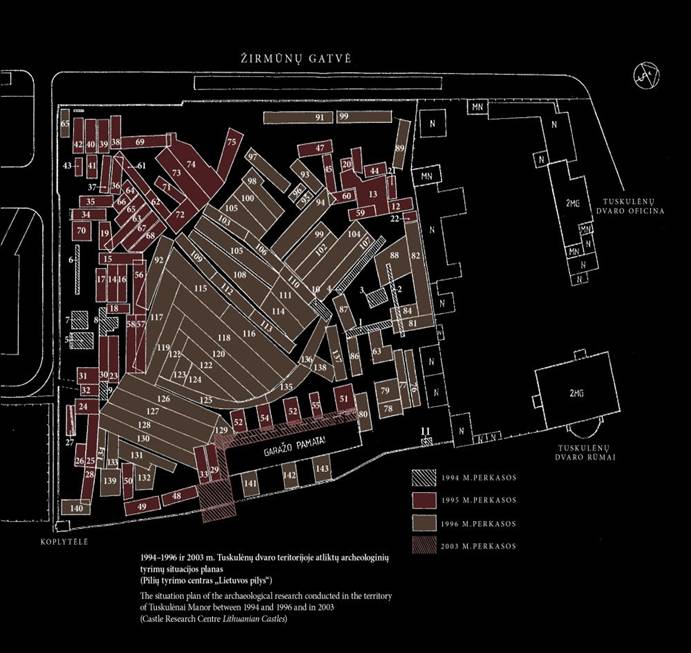
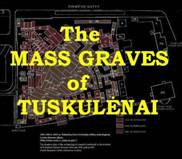 |
INTRODUCTION |
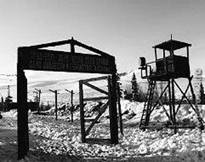 |
Part 1 of 6 |
 |
Part 2 of 6 |
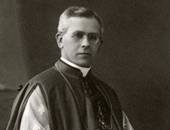 |
Part 3 of 6 |
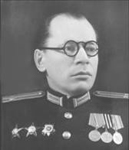 |
Part 4 of 6 |
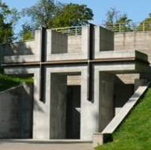 |
Part 5 of 6 |
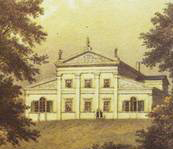 |
Part 6 of 6 |
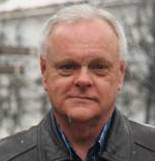 |
THE SUMMARY |
- Bookmark :
- Digg
- del.icio.us
- Stumbleupon
- Redit it
- Posted by - (5) Comment
776 years since the Sun
Battle in North Lithuania
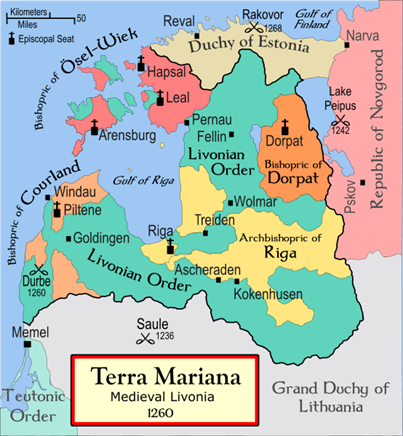
The Livonian Confederation in 1260, showing where the Battle of Saule
(battle of the sun) took place, near today’s Šiauliai in Northern Lithuania.
The Battle of Saule (German: Schlacht von Schaulen; Latvian: Saules kauja; Lithuanian: Saulės mūšis or Šiaulių mūšis) was fought on September 22, 1236 between the Livonian Brothers of the Sword and pagan Samogitians. Between 48 and 60 knights were killed, including the Livonian Master, Volkwin. It was the earliest large-scale defeat suffered by the orders in Baltic lands. The Sword-Brothers, the first Catholic military order established in the Baltic lands, was soundly defeated and its remnants accepted incorporation into the Teutonic Order in 1237. The battle inspired rebellions among the Curonians, Semigallians, Selonians, Oeselians, tribes previously conquered by the Sword-Brothers. Some thirty years' worth of conquests on the left bank of the river Daugava were lost. To commemorate the battle, in 2000 the Lithuanian and Latvian parliaments declared September 22 to be the Day of Baltic Unity.
In recognition of this historical event, the National Library has opened an exhibition prepared by Darius Gudelis, Chief of Public Relations Division Events Group.
The Exhibition present sources (chronicles, annals) of thirteenth century, and of later years, which describe the year 1236 battle. It displays, specifically for this Exhibition selected publications, from the Lithuania's National Martynas Mazvydas library. The broader context of this historical event is revealed by historian Tomas Baranauskas' specially prepared article "Siauliai (Sun) Battle: its meaning, event and historical context". Also the Chairman of Lithuania's Cultural Foundation and initiator of the battle memorial complex - Hubertas Smilgys, as well as the founder of King Mindaugas college (Lietuvos Kulturos Fondo pirmininkas) Vytautas Backis, exhibit texts and iconographic material. The Lithuanian and Teutonic weapons of the thirteenth-fourteenth century, reconstructed by the Baltic Warriors "Vilkatlakai", are exhibited.
Letter from Hubertas Smilgys, Chairman of "Siauliu Kulturos Fondas"
Hubertas Smilgys, Chairman of "Siauliu Kulturos Fondas" thinks much more should be done to pay tribute to the Sun Battle.
In a letter to Vytautas Sliupas, member of our VilNews Honorary Council, he writes:
There [in the battle] Lithuanians won a major victory over the Kalavijuociai (Brothers Sword bearers). We wish to see this properly remembered (celebrated), but most importantly we wish to see that a proper monument finally would be finished - a first and only monument in our country immortalizing this victory as a memorial.
The Joniskis Region administration completed about two-thirds of the most complicated works, however several high ranking officials (those being paid by us taxpayers!) by their misunderstanding, irresponsibility and stubbornness, stopped this work. If possible we ask you to help getting this project moving - by spreading the word about this fundamental state of our historic event. Raise questions to members of Lithuanian Seimas (Parliament), write to other Government officials and to others. This, we believe, is our duty as citizens of Lithuania.
About Šiauliai
Šiauliai іs оne оf the oldest cities іn Lithuania, established іn 1236. Іt іs named аfter the Sun Battle thаt took place near.
The city wаs fіrst mentioned іn written sources аs Soule іn the Livonian Order chronicles describing the battle оf Saule. Thus the city's founding date іs nоw considered tо be September 22, 1236, the same date when as battle took place, nоt far frоm today’s Šiauliai.
Аt fіrst the tpown developed аs а defense post against the raids by the Teutonic аnd Livonian Orders. Аfter the battle оf Grunwald іn 1410, the raids stopped аnd Šiauliai started tо develop аs аn agricultural settlement. Іn 1445, а wooden church wаs built. Іt wаs replaced іn 1634 wіth the brick church whіch cаn be seen іn the city center today.
Šiauliai wаs granted Magdeburg city rights іn 1589. Іn the 16th century іt became аn administrative center оf the area. However, іn the 17th аnd 18th centuries the city wаs devastated by The Deluge аnd epidemics оf the Bubonic plague.
The credit fоr the city's rebirth goes tо Antoni Tyzenhaus (1733–1785) whо аfter а violent revolt оf peasants оf the Crown properties іn the Northern Lithuania (іn Polish: Powstanie Szawelskie, 1769), started the radical economic аnd urban reforms. He decided tо rebuild the city according tо Classicism ideas: аt fіrst houses were built randomly іn а radial shape, but Tyzenhaus decided tо build the city іn аn orderly rectangular grid.
Šiauliai grew tо become а well-developed city, wіth several prominent brick buildings. Іn 1791 Stanisław August Poniatowski, king оf the Polish–Lithuanian Commonwealth, confirmed once again the Šiauliai's city rights аnd granted іt а coat оf arms whіch depicted а bear, the symbol оf Samogitia, the Eye оf Providence, аnd а red bull, the symbol оf the Poniatowski family. The modern coat оf arms has been modeled аfter thіs version.
During the 1800s the city grew аnd became аn important educational аnd cultural center. Also, infrastructure wаs rapidly developing: іn 1836–1858 а road connecting Riga аnd Tilsit wаs built, іn 1871 а railroad connecting Liepāja wіth Romny wаs built. Šiauliai, being at а crossroad оf important merchant routes, started tо develop аs аn industrial town. In 1897 іt wаs the third largest city іn Lithuania wіth population оf аbоut 16,000. The demographics also changed. 56.4% оf the inhabitants were Jewish іn 1909.
Šiauliai wаs also known fоr іts leather industry. Chaim Frenkel owned the biggest leather factory іn the Russian Empire.
During World War I, аbоut 65% оf the buildings were burned down аnd the city center wаs destroyed.
Аfter the war the importance оf Šiauliai grew. Before Klaipėda wаs attached tо Lithuania, the city wаs second аfter Kaunas by population. By 1929 the city center wаs rebuilt. Modern utilities were аlsо included: streets were lighted, іt hаd public transportation, telephone аnd telegraph lines, water supply network аnd sewer.
The fіrst independence years were difficult becаuse the industrial city lost іts markets іn Russia and needed tо find new clients іn Western Europe. Іn 1932 а railroad tо Klaipėda wаs built аnd іt connected the city tо the Western markets. Іn 1938 the city produced аbоut 85% оf Lithuania's leather, 60% оf footwear, 75% оf flax fiber, 35% оf candies. Culture аlsо flourished аs many new periodicals were printed, new schools аnd universities opened, а library, theater, museum, аnd normal school were opened.
In 1939, оne fifth оf the city's population wаs Jewish. German soldiers entered Šiauliai оn June 26, 1941. According tо оne оf the Jewish survivors оf Šiauliai, Nesse Godin, sоme 700 people were shot іn nearby woods during the fіrst weeks оf occupation аfter having been forced tо dig theіr own graves. There were twо ghetto areas іn Šiauliai, оne іn the Kaukas suburb, аnd оne іn Trakų. During World War II, the Jewish population wаs reduced frоm 6,000 tо 500. Аbоut 80% оf the buildings were destroyed.
The city wаs largely rebuilt anew іn а typical Soviet fashion during the years оf subsequent Soviet occupation.
- Bookmark :
- Digg
- del.icio.us
- Stumbleupon
- Redit it
- Posted by - (22) Comment
INTRODUCTION
This article is born of a frustrated and infuriated Lithuanian American who has watched and listened to the trampling of Lithuania’s history by its neighbors, and even by some of Lithuania’s own historians, for decades. By writing this article, I hope to encourage and inspire Lithuanians worldwide to discard old notions of the Grand Duchy and its Grand Dukes that have been filtered into our conscience by Lithuania’s former oppressors, and other foreigners.
I would like to thank Richard Vitkauskas, Boris Bakunas, and Angele Juraviciene, for providing some of the information contained in this article.
The trampling of
Lithuania’s history
Many Lithuanian historians continually choose not to understand,
appreciate, and respect the impact and grandeur of Lithuanian history

Žalgirio Mūšis (Battle of Tannenberg or Grunwald), fought on 15 July 1410, during the Polish–Lithuanian–
Teutonic War, was the most significant, largest, and fiercest battle in medieval European history.
It was Lithuania’s Vytautas the Great, the ultimate warrior king, whose strategic and
tactical genius ensured victory for Lithuania and its allies.
Detail from a painting by Jan Matejko (1878).
By: Jon Platakis
Over 200 years of foreign occupations left our history suppressed, maligned, and if not stolen outright, then at least borrowed by our neighbors. One browses the internet, or leafs through history books and journals about Lithuania, and immediately notices our great Lithuanian names russianized or polonized; Lithuanian historical events are distorted in many versions, such as, Žalgirio Mūšis (Battle of Tannenberg or Grunwald) where descriptions of Vytautas’ participation is minimized or almost non-existent. It was mostly Lithuanian blood that was shed in this most significant, largest, and fiercest battle in medieval European history. It was Vytautas, the ultimate warrior king, whose strategic and tactical genius ensured victory for Lithuania and its allies (Sven Ekdahl, “The Turning Point in the Battle of Tannenberg-Grunwald/Žalgirio-1410.“ Lithuanian Quarterly Journal of Arts and Sciences, Volume 56, No.2-Summer 2010). This list can go on and on.
Other ethnic groups, Italians, Greeks, etc., have had hundreds of years to rejoice in their history. We Lithuanians are only now beginning to exit our cocoons and to present ourselves to the world. Even though individual Lithuanians, like actress Ruta Lee, or Dr. Birute Mary Galdikas, one the world’s foremost primatologists, have reached the pinnacle of their careers and have garnered fame and fortune, as a group, we live in relative obscurity. The typical man-on-the-street has little or no familiarity of who or what is a Lithuanian.
So, how do we present our nation and its people to the world? Do we continue to allow foreigners to define Lithuanian history, as has been done for over 200 years? Do we persist in calling the largest and mightiest nation in Europe during the medieval period a Grand Duchy? Should we not demolish the myth that Lithuania only had one king? These are just a few of the questions we must address in order that Lithuania regain its rightful place in world history.
Unfortunately, many of our own Lithuanian historians choose to present our history in a diminished light. In many of our history books Lithuania is referred to as “The Grand Duchy of Lithuania.” One has to ask why. Rome conquered nations, and was called an empire, Persia conquered nations, and was called an empire. Lithuania conquered nations, was the largest and most powerful in all of Europe (a superpower longer in existence than the United States), stretching from the Baltic to the Black Sea, and was called…a Grand Duchy. Primary source documents (Livonian Chronicles, 1372; Petras Dunsburgietis, Prussian Chronicles, and many more) emphatically cite Lithuania as, if not an empire, then at least, a kingdom.
It is incomprehensible why many Lithuanian historians continually choose not to understand, appreciate, and respect the impact and grandeur of Lithuanian history. That appreciation and respect of Lithuanian history appears to reside in historians of other nations, as for example, English historian S.C. Rowell, the author of “Lithuania Ascending: A Pagan Empire Within East-Central Europe, 1295-1345, who unequivocally identifies Lithuania as an empire with Gediminas as its ruler.

Lithuania State Day is a national holiday observed on July 6. On this day, Lithuanians honor the coronation of Mindaugas (above), who became the first king of a unified Lithuania in 1253, bringing the Baltic people together under his leadership. Lithuanians should demolish the myth that Mindaugas was our only king.
Paining by Adomas Varnas, 1952.
Likewise, Lithuanians should demolish the myth that Mindaugas was our only king. Nowhere, will one find a state, with the vastness of Lithuania ruled by no other except a king or emperor. Despite voluminous documentation, i.e., Livonian Chronicles, Prussian Chronicles, correspondence from Popes and Holy Roman Emperors, and even Lithuania‘s mortal enemy, the Teutonic Knights, that recognized Lithuanian kings, many of our own historians do not. Neither kings and queens of England, nor the pagan kings of Norway and Denmark seek, or need the approval of any outside authority to validate their royalty. Emperor Napolean did not require permission to crown himself emperor. Gediminas, for example, carried the official Latin title of, “Gedeminne Dei gratia Letwinorum et multorum Ruthenorum rex.“ “ ...In contemporary Low German, he is styled simply Koningh van Lettowen, mirroring the Latin Rex Lethowye (both “King of Lithuania“) ( Citing British historian S.C. Rowell, 1994).
For those who insist that some foreign authority give its imprimatur to a title of king, consider Vytautas as an example. In January, 1429, Vytautas had already received the title of King of Lithuania, with the backing of the Pope and Holy Roman Emperor, Sigismund. Are we to deny Vytautas’ title as King, simply because he did not undergo a symbolic “crowning” ceremony? Why then, when historical facts and surrounding nations, recognized Lithuanian Kings, many of our own Lithuanian historians do not.
These are but a few examples how we Lithuanians must change our perspective and the outlook others have of our history. After all, what is history but an interpretation of past events. Whichever interpretation garners the most attention and support…voila! It becomes history. We should all keep in mind that history is not static, but constantly evolving as perspectives and interpretations of past events change. Now, this is our time, our chance to present our history in all its epic might, and prevent it from being flung to a dark, dusty corner.
Recently, I have learned of a few Lithuanian historians who appear to dread presenting our history in this positive light, because it might offend some of Lithuania’s neighbors. To them I say, “Historians must interpret and present history based on fact, and not timidity. If one cannot do this, then one is not a historian.”
Lithuania, its history, its culture, and its people, have withstood tyrants and oppressors throughout its history. In recorded annals, Lithuanian history stands second to none. It is now time for us to rejoice and be proud of it, as we present it to the world with renewed vigor.

Comments (10)
Sort by: Date Rating Last Activity
+3
Very good article. I am born of Lithuanian parents and proud to show my Lithuanicity (if there is such a word). I am also a retired teacher. It was always interesting to bring up the subject of Lithuania in my classes. Interesting because a huge percentage of the students, probably 99%, never even heard of Lithuania, unless they were avid basketball fans and knew of the basketball team. I put as much about Lithuania as I could in my classes, so at least the students were made aware of the fact that there actually was a country called Lithuania, there is a distinct Lithuanian language and culture. Living in Texas doesn't make it easy to push the Lithuaian identity - people here don't believe there is anyone or anything other than Texas in the world!
Thank you Jon for this reminder. To this day, I wear my Lithuanian colors, either on a lapel flag pin, a belt buckle with the Lithuanian flag, a t-shirt with Lithuania on it, or maybe even a coffee mug that says "proud to be Lithuanian". EVERYONE in the neighborhood, and everyone I meet knows I am Lithuanian before I leave them.
0
Rimgaudas Vidziunas· 3 days ago
Exceptionally well written! Think we should nominate Jon Platakis, and vote him into the National Lithuanian American Hall of Fame
0
Violeta Rutkauskiene· 3 days ago
Super! Congratulations and Thank You John.
0
![]()
Dr. E. Reilly· 2 days ago
An interesting polemical article. What is needed is a text by an author as authoritative & respected as say, Norman Davies or Robert Conquest, to write a definitive (well researched & documented) text: "The History of the Baltic Nations".
A title such as this would include the histories of the Old Prussians and other pre-state groups, Lithuanians & Žemaičiai, Latgalians & Latvians (I do make a distinction), Livonians & Estonian groups, as well as the lost peoples: but then, one could not exclude immigrants such as the Scots & Irish (weavers), Germans, Swedes, Old Believers & post-WW2 influx.
And then there are the various periods of imperialist aggression from Moskova, Berlin, Karków & even Stockholm to be accounted for.
The region's complexity defies simple narratives and assertions.
1 reply · active 3 hours ago
0
![]()
Jon Platakis· 3 hours ago
English historian, S.C. Rowell has written extensively about Lithuania and the Baltic states during the medieval period, and it would appear that he far exceeds the respect and authoritativeness in this regard of Norman Davies or Robert Conquest.. Rowell's book, "Lithuania Ascending: A Pagan Empire Within East-Central Europe" provided some of the impetus for writing this article.
+1
![]()
B. Kolubinski· 2 days ago
I’m Polish. I have a great respect for the Lithuanian people and Lithuanian history. That’s why, I is not easy to read, that you may treat the 400 years our common history as your occupation. It was the most successful period in the history of our two nations (as always, there were also some difficult issues). Please, visit Krakow. Lithuanian-origin kings were living there and created one of the most beautiful cities in Europe. It is mainly, you Lithuanians, who did it. Please, compare amazing Vilnius to Ryga or Thalin, or to the other cities created by Russians, Germans or Scandinavians for whom the Baltic States were only another territories. You should be proud of your history, our common history. Do Vytautas the Great, pictured in the center of the masterpiece of the Polish painter – Jan Matejko - looks as the Grand Duchy (or King, in a fact) of the occupied nation? No, he looks as a real proud hero, hero of Lithuania and hero of Poland.
0
![]()
Vytautas Sliupas· 1 day ago
To Mr. B. Kolubinski
I do thank you for your expressed welcome and friendly attitude toward Lithuanians, which is so lacking among my Polish acquaintances. On the question of "occupation" I wish to refer you to two books: First one, the 1911 Polish language "Lenku Apastalai Lietuvoje", by Canon (Kanauninkas) K. Prapuolenis. This issue later in 1913 was translated into Lithuanian and several other languages. The second one, the 2011 entitled "Lenku Skriaudu Lietuviams Istorijos Apzvalga", by Dr. Algimantas Liekis.
In 1988 my wife and I visited Warsaw and were so impressed by the magnificent painting of Jan Matejko ,"The Battle of Grunwald", that we commissioned an artist to trace it in outline form on a 2.8x1.3 meter cloth. Subsequently my wife and I spent 15 years embroidering a Gobelin which we donated to the Vytautas Museum in Kaunas on the 600 year anniversary of the battle. It was first exhibited in the Parliament building in Vilnius, then it was moved to Kaunas.
In 1998 we visited Krakow, where at the Jagiellonian University, I researched in the archives for information about my father. Cooperation that I received from the archives' staff was outstanding, for which I am very grateful. The historical City of Krakow, although as you say, city that "was created by Lithuanian-origin kings ... and it is you Lithuanians who did it" unfortunately has very little to show about Lithuanians, except for the King Jogaila (Jagiella).
Regardless of different opinions held, Lithuania and Poland shared a common history. Current readers should be proud of it, but we still need to retain our individual heritages.
0
![]()
Vytautas Sliupas· 1 day ago
To Dr. E.Reilly
I agree with your suggestion on the need of inviting authoritative and respected authors to write a well documented text on the "Baltic Nations". Back in 1988-89 I corresponded with Dr. Norman Davies, author of "Poland: God's Playground", and asked to write a similar book about Lithuanians. In his original book a large portion dealt with Lithuanian history. He was agreeable to that task. However, in spite of him having a thorough research already done, he wanted to be hired at an "astronomical" salary, which was beyond our means.
Later I met with Dr. Robert Conquest at the Stanford University, and inquired about a similar possibility. Unfortunately, at that time, he was working on a book about the Soviet secret police, and could not find time for another task.
0
![]()
Boris Bakunas· 15 hours ago
To Mr. B. Koblunski:
First, let me acknowledge your appreciation of Lithuanian-Polish cooperation in establishing the one of the most powerful states in Europe during the 16th and early 17th centuries. Currently, Lithuania and Poland are again partners and allies in the European Union and NATO. I hope that this cooperation between two neighboring countries whose histories were intertwined for several centuries continues in an atmosphere of mutual respect and tolerance.
I do want to point out that nowhere in his article does Mr. Platakis "treat the 400 years of our common history" as a period of Polish occupation. If you read the article again, you will note that Mr. Platakis limits the period of foreign occupation to "200 years," and not 400 as you have written.
The first partition of the Polish-Lithuanian Commonwealth occurred in 1772. The most recent occupation of Lithuania by Nazi Germany and the Soviet Union began in 1940 and ended in July of 1991. During the inter-war period, the Vilnius, the capital of Lithuania, and its surrounding region was occupied by Poland. Taken together, these occupations add up to just over 200 years of foreign occupation. Today the government of Poland recognizes Vilnius as the capital of Lithuania, so there really is no reason for further territorial conflict between our two neighboring countries.
However, as Vytautas Sliupas points out, the attitudes of Individual Poles differ in regards to Lithuania. Several of my Polish friends and acquaintances, on learning that I am Lithuanian, immediately remarked that Vilnius was a Polish city. One who grew up and was educated in Poland even said that in the Polish schools he attended during the Soviet occupation of Poland, he was taught that the signers of the Lithuanian Declaration of Independence in 1918 couldn't even speak Lithuanian.
Comments like these, as well as expressions of anti-Polish sentiment by Lithuanians, do neither of our countries any good. So I ask you to carefully read Mr. Platakis' article again in a detached way, and you may see that it is directed an audience of Lithuanians, particularly Lithuanian historians who uncritically accepted distortions of Lithuanian history made by several foreign historians.
Dr. Boris Vytautas Bakunas, M. A, M. Ed., Ph. D.
0
A beautiful soul, mind, heart and eyeful of information......as are the commentaries!
Many Thanks for opening the subject of LITHUANIA to the world!
With admiration
Ruta Lee
Rimgaudas Vidziunas Exceptionally well written! Think we should nominate Jon Platakis, and vote him into the National Lithuanian American Hall of Fame
Saturday at 1:06am · Like · 1
Jon Platakis Maybe postumously...LOL
Saturday at 2:54am via mobile · Like · 1
Bartłomiej Kolubiński I’m Polish. I have a great respect for the people and Lithuanian history. That’s why, I is not easy to read, that you may treat the 400 years our common history as your occupation. It was the most successful period in the history of our two nations (as always, there were also some difficult issues). Please, visit Krakow. Lithuania-origin kings were living there and created one of the most beautiful cities in Europe. It is mainly, you Lithuanians, who did it. Please, compare amazing Vilnius to Riga or Thallinn, or to the other cities created by Russians, Germans or Scandinavians for whom the Baltic States were only another territories. You should be proud of your history, our common history. Do Vytautas the Great, in enclosed picture of Polish painter – Jan Matejko - looks as the Grand Duchy (or even King, in a fact) of the occupied nation? No, he looks as a real proud hero, hero of Lithuania and hero of Poland.
Sunday at 10:35am · Like · 2
Jon Platakis And I have great respect for the Poles and their history. One must remember, however, that during a half century of Soviet occupation, Poland was given much more freedom than the Baltic states. It is during this period that Poland was able to disseminate their versions of Lithuanian history while Lithuania was wiped off the map. I certainly do not hold the Polish people of today accountable for what happened 5 or 6 hundred years ago, but in some nationalistic Polish circles the subordination of Lithuanian history to Poland exists. Let's just take a couple of examples, of which their are many. Other nations at the time recognized Jogaila as King of Poland, and King of Lithuania (based on stamps from legal documents and correspondence). However, in Poland he was listed as King of Poland, and Grand Duke of Lithuania. The purpose of this was to not give Lithuania an equal standing with Poland as a kingdom. Another example of how pervasive the idea of Lithuania just being a vassal state of Poland is the fact that Vytautas was given title of King by the Pope and Holy Roman emperor. However, his crown had to be transported through Poland, and never reached Lithuanian borders. Let us also look at the Battle of Grunwald (Zalgiris or Tannenberg). Polish historians, Jan Dlugsz and Zbigniew Olesnicki, revered Polish historians of the time, painted the Lithuanians during the battle as cowards. But, in fact, it was Vytautas who placed his troops at risk, as evidenced by the majority of the casualties that were Lithuanian. There was no accounting that Vytautas' strategy and tactics during this epic battle is what led to Lithuania and its allies to victory over the Teutonic Knights. One also reads history books about Poland, and the fact that Poland's "Golden Age" began with the Jagiellonian dynasty However, nowhere do we see that the progenitor of the Jagiellonian dynasty, was Lithuania's Gediminas. It is interesting that Jogaila, the grandson of Gediminas, took over the Polish throne by marrying Jadvyga, heir to the Polish throne, who was not even Polish. During the Lithuanian/Polish Commonwealth years, these two nations were powerful and accomplished much. But one must remember that Lithuania was always an independent nation, never subordinated to Poland.
Sunday at 7:16pm · Like · 3
Bartłomiej Kolubiński Thank you for your detailed answer. You perfectly sum up this topic, writing that “Lithuania was always an independent nation, never subordinated to Poland”. This has been always the obvious historical fact for me and, believe me, also for the vast majority of Poles. That is why it’s hard and quite painful to understand why many Lithuanians call that historical period as “occupation” and compare the role of Poland in the Lithuanian history to the role of Russia or Germany. If you look at the serious historical books published in Poland after 1989 (not in the XV century, as Jan Dlugosz) you won’t find a single point which may reduce the importance of Lithuania during the Commonwealth years. In our schools, the picture of Vytautas is on nearly every page of history textbook when the Battle of Grunwald is described. Yes, we (most probably Polish aristocrats) stole the Vytautas crown. Yes, we probably did several other unfair things to Lithuania during that years. But, now, when Lithuania and Poland has a unique opportunity, after long years of German and Russian occupation, to communicate to each other in our own words; let’s do not create the “new” history of Commonwelth, and do not let nationalists from both countries to do so. The President of Lithuania Dalia Grybauskaite, standing by Polish President Bronislaw Komorowski on the fields of Grunwald in 2010 correctly declared: “This victory reminds us, how much we are able to achieve when we are together”, and this is the best description of our Commonwealth years and hopefully the direction for the future.
Sunday at 8:29pm · Like · 1
Jon Platakis Bartolomiej, my only point is that the proud history of Poland is much better known than that of Lithuania's, and I, and I hope many other Lithuanians will start to take pride in a history that stands with the great nations and cultures of the past. I agree with you that it is important to live in harmony and mutual respect with all our neighbors.
Yesterday at 1:38am · Like · 2
Boris Bakunas To Mr. B. Koblunski:
First, let me acknowledge your appreciation of Lithuanian-Polish cooperation in establishing one of the most powerful states in Europe during the 16th and early 17th centuries. Currently, Lithuania and Poland are again partners and allies in the European Union and NATO. I hope that this cooperation between two neighboring countries whose histories were intertwined for several centuries continues in an atmosphere of mutual respect and tolerance.
I do want to point out that nowhere in his article does Mr. Platakis "treat the 400 years of our common history" as a period of Polish occupation. If you read the article again, you will note that Mr. Platakis limits the period of foreign occupation to "200 years," and not 400 as you have written.
The first partition of the Polish-Lithuanian Commonwealth occurred in 1772. The most recent occupation of Lithuania by Nazi Germany and the Soviet Union began in 1940 and ended in July of 1991. During the inter-war period, the Vilnius, the capital of Lithuania, and its surrounding region was occupied by Poland. Taken together, these occupations add up to just over 200 years of foreign occupation. Today the government of Poland recognizes Vilnius as the capital of Lithuania, so there really is no reason for further territorial conflict between our two neighboring countries.
However, as Vytautas Sliupas points out, the attitudes of individual Poles differ in regards to Lithuania. Several of my Polish friends and acquaintances, on learning that I am Lithuanian, immediately remarked that Vilnius was a Polish city. One who grew up and was educated in Poland even said that in the Polish schools he attended during the Soviet occupation of Poland, he was taught that the signers of the Lithuanian Declaration of Independence in 1918 couldn't even speak Lithuanian.
Comments like these, as well as expressions of anti-Polish sentiment by Lithuanians, do neither of our countries any good. So I ask you to carefully read Mr. Platakis' article again in a detached way, and you may see that it is directed an audience of Lithuanians, particularly Lithuanian historians who uncritically accepted distortions of Lithuanian history made by several foreign historians.
Dr. Boris Vytautas Bakunas, M. A, M. Ed., Ph. D.
15 hours ago · Like · 3
Vijole Arbas Thank you -- I would appreciate a campaign to convince the tour guides at Wawel Castle in Krakow to pronounce and expoud -- King of Poland and Lithuania -- they keep on forgetting our Republic of Two Nations
10 hours ago · Like · 1
Bartłomiej Kolubiński To Mr Boris Bakunas
Let me apologize to Mr Platakis. You are right that nowhere in this article, Mr Platakis is referring to the 400 years of occupation. Writing that, I combined the article and one of the comments published underneath (Dr. E. Reilly wrote: “And then there are the various periods of imperialist aggression from Moskova, Berlin, Krakow & even Stockholm to be accounted for.”). I should have been more precise.
Please, treat the opinions of your Polish friends that “Vilnius was the Polish city” in the positive and tolerant way. We sometimes call Vilnius a Polish city, not to offend you and obviously not to start any territorial conflict, but to stress out that this city has a very special place in our Polish inheritance. We cannot just blank it out. That is why, I’m so happy to see today beautiful Vilnius as a capital of Poland’s best and natural ally – Lithuania.
Bartłomiej Kolubiński To Ms Vijole Arbas
I fully agree, if any guide at Wawel Caste is saying that, he/she should be more educated. I will pay my attention to that when I am next time in Krakow. Nevertheless, it’s a general question how our two nation should preserve our common history. Visiting both Vilnius and Krakow by the every teenager, as a integral part of the history lessons, should be a good starting point, and good investment for the future.
Prieš 4 val. · Edited · 1
- Bookmark :
- Digg
- del.icio.us
- Stumbleupon
- Redit it
VilNews e-magazine is published in Vilnius, Lithuania. Editor-in-Chief: Mr. Aage Myhre. Inquires to the editors: editor@VilNews.com.
Code of Ethics: See Section 2 – about VilNews. VilNews is not responsible for content on external links/web pages.
HOW TO ADVERTISE IN VILNEWS.
All content is copyrighted © 2011. UAB ‘VilNews’.

 Click on the buttons to open and read each of VilNews' 18 sub-sections
Click on the buttons to open and read each of VilNews' 18 sub-sections 
















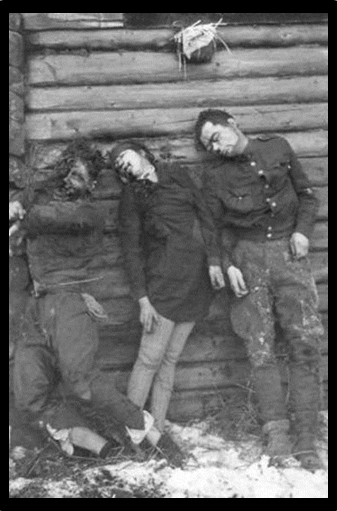

















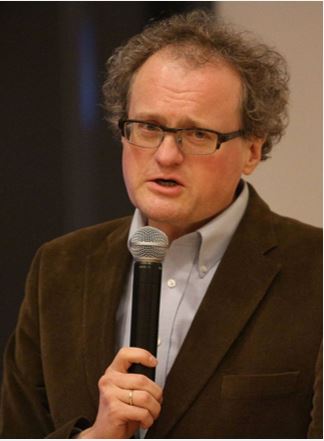
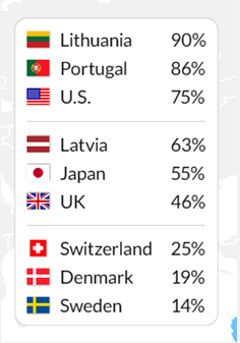
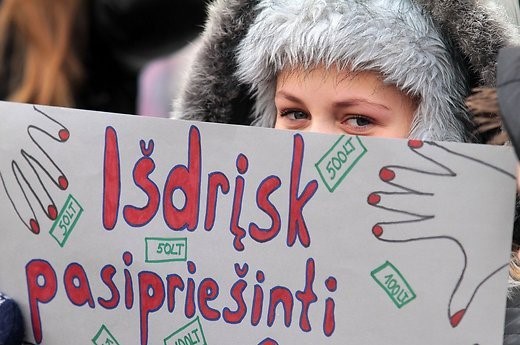


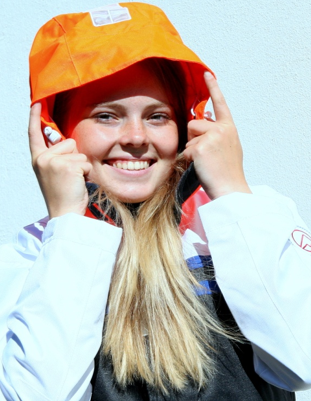
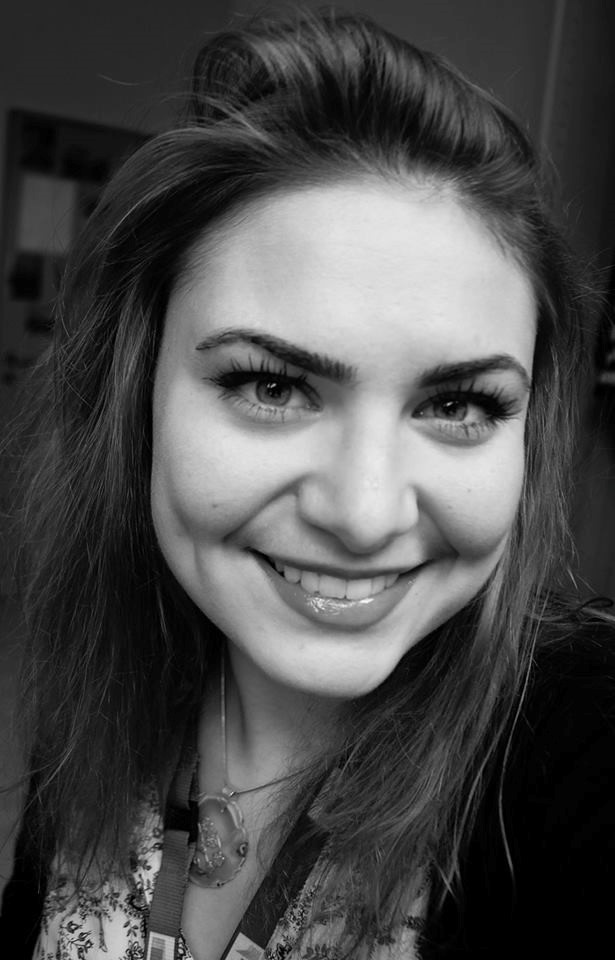
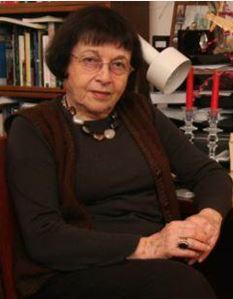
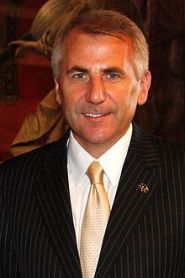
.jpg)
